#Primary Customer Research
Text
Understanding Primary Customer Research: Your Key to Informed Decision-Making
In today's competitive business landscape, understanding your customers is more crucial than ever. One of the most effective ways to gain insights into your target audience is through primary customer research. By conducting thorough research directly with your customers, you can gather valuable data and make informed decisions that drive your business forward. In this guide, we'll delve into the importance of primary customer research and explore how it can benefit your organization.
What is Primary Customer Research?
Primary customer research involves collecting data directly from your target audience to understand their needs, preferences, behaviors, and opinions. This type of research allows businesses to gather first-hand information rather than relying on secondary sources or assumptions.
Primary research methods can include:
Surveys: Online or offline questionnaires designed to gather specific information from respondents
Interviews: One-on-one or group discussions with customers to gain deeper insights into their experiences and preferences.
Focus Groups: Small, moderated discussions with a select group of participants to explore topics in-depth.
Observational Studies: Directly observing customers in their natural environment to understand their behaviors and interactions.
Experiments: Testing hypotheses or product features with real customers to gauge their reactions and preferences.
The Importance of Primary Customer Research
1. Understanding Customer Needs
Primary research allows businesses to identify what their customers truly want. By directly engaging with customers, you can uncover pain points, preferences, and unmet needs that may not be apparent through other methods.
2. Product Development and Innovation
Insights from primary research can drive product development and innovation. By understanding customer preferences and behaviors, businesses can create products and services that better meet the needs of their target audience, leading to higher satisfaction and loyalty.
3. Targeted Marketing
Effective marketing relies on a deep understanding of your audience. Primary research provides the insights needed to create targeted marketing campaigns that resonate with customers, leading to higher engagement and conversion rates.
4. Competitive Advantage
Businesses that invest in primary customer research gain a competitive advantage. By understanding their customers better than their competitors do, they can tailor their offerings and strategies more effectively, leading to increased market share and profitability.
5. Risk Mitigation
Making business decisions based on assumptions or incomplete information can be risky. Primary research helps mitigate these risks by providing accurate data and insights that inform decision-making, reducing the likelihood of costly mistakes.
Conducting Primary Customer Research
1. Define Objectives
Clearly define the objectives of your research. What specific questions do you want to answer? What insights are you seeking? Having a clear focus will help you design effective research methods.
2. Choose the Right Method
Select the research method that best suits your objectives and target audience. Surveys are ideal for gathering quantitative data, while interviews and focus groups are better for qualitative insights.
3. Design Your Research
Develop your research instruments, such as survey questionnaires or interview guides, ensuring they are clear, concise, and unbiased. Pilot testing can help refine your approach before conducting the full study.
4. Recruit Participants
Recruit participants who represent your target audience. Use diverse sampling techniques to ensure a comprehensive understanding of your customer base.
5. Collect Data
Execute your research plan, collecting data according to your chosen method. Ensure accuracy and reliability by following established protocols and avoiding leading questions or biases.
6. Analyze and Interpret Results
Once data collection is complete, analyze the results to identify key findings and insights. Look for patterns, trends, and outliers that can inform your decision-making process.
7. Take Action
Use the insights gained from your research to inform business decisions, whether it's refining product features, adjusting marketing strategies, or improving customer service.
Conclusion
Primary customer research is a powerful tool for businesses seeking to understand their target audience and make informed decisions. By directly engaging with customers, organizations can uncover valuable insights that drive product innovation, targeted marketing, and competitive advantage. By following best practices in research design and execution, businesses can unlock the full potential of primary research and stay ahead in today's dynamic marketplace.
For businesses looking to embark on primary customer research, partnering with a reputable research firm like Philomath Research can provide expertise and guidance every step of the way, ensuring valuable insights that lead to tangible business outcomes.
FAQs
1. What is primary customer research?
Primary customer research involves directly collecting data from your target audience to understand their needs, preferences, behaviors, and opinions. It allows businesses to gather first-hand information rather than relying on secondary sources or assumptions.
2. Why is primary customer research important?
Primary research is essential for understanding customer needs, driving product development and innovation, creating targeted marketing campaigns, gaining a competitive advantage, and mitigating risks associated with decision-making.
3. What are the methods used in primary customer research?
Primary research methods include surveys, interviews, focus groups, observational studies, and experiments. Each method has its advantages and is chosen based on research objectives and target audience.
4. How can businesses conduct primary customer research?
To conduct primary customer research, businesses should define objectives, choose the right method, design research instruments, recruit participants, collect data, analyze and interpret results, and take action based on insights gained.
5. How can businesses ensure the accuracy of their primary research data?
Businesses can ensure the accuracy of their primary research data by following established protocols, avoiding leading questions or biases, using diverse sampling techniques, and pilot testing research instruments before full implementation.
6. How can businesses use the insights from primary customer research?
Businesses can use insights from primary customer research to inform product development, marketing strategies, customer service improvements, and other business decisions that drive growth and success.
7. What are the benefits of partnering with a research firm for primary customer research?
Partnering with a reputable research firm like Philomath Research can provide expertise and guidance throughout the research process, ensuring valuable insights that lead to tangible business outcomes. Research firms can also offer access to specialized methodologies and resources that businesses may not have internally.
0 notes
Text
Christian websites: here is a detailed description of how to go to confessional and what to say in confessional. we’re providing this to help people confess their sins and be forgiven by god
me: thank you this is very helpful information for writing gay porn
#honestly christian customs have been one of the easiest things I’ve had to research#bc christians LOVE to tell you all about Christianity#for most things I’ve ended up w like. blogs or pop science articles#but for this I can have The Church (tm) tell me all the details I need. primary fucking sources#i will say writing a sex scene w a guy in full catholic priest garments is not the easiest but not for lack of research material
8 notes
·
View notes
Text
What Is Market Research: Methods, Types & Examples
Learn about the fundamentals of market research, including various methods, types, and real-life examples. Discover how market research can benefit your business and gain insights into consumer behavior, trends, and preferences.
#Market research#Methods#Types#Examples#Data collection#Surveys#Interviews#Focus groups#Observation#Experimentation#Quantitative research#Qualitative research#Primary research#Secondary research#Online research#Offline research#Demographic analysis#Psychographic analysis#Geographic analysis#Market segmentation#Target market#Consumer behavior#Trends analysis#Competitor analysis#SWOT analysis#PESTLE analysis#Customer satisfaction#Brand perception#Product testing#Concept testing
0 notes
Text
Why GMP Compliance Is Paramount For High-Quality Mesenchymal Stem Cell?
The past twenty years have witnessed a fascinating unboxing of the mesenchymal stem cells. These microscopic marvels hold the potential to revolutionize how we approach disease. These mesenchymal stem cells are extracted from adult cells, and hence, they rarely receive any ethical backlash. Unlike most stem cells, mesenchymal ones boast remarkable versatility and can morph into diverse cell types, from bone to blood vessels. These cells carry several regenerative and anti-inflammatory prowess, which has propelled them to the forefront of stem cell therapy. The use in therapeutic applications has ignited a surge in demand that outpaces our current production capabilities.
Given the surge in demand for MSCs for research, providing researchers with high-quality stem cells for reproducible research is necessary. Enter the realm of Good Manufacturing Practices (GMP), our roadmap towards building factories for these cellular powerhouses, ensuring not just quantity but unparalleled quality and safety. Buckle up, science researchers, for we’re about to delve into the intricate dance of scaling up MSC production while upholding the highest standards, paving the way for a future where these microscopic maestros weave their magic on a grand scale.
#Mesenchymal Stem Cells#MSCs#GMP Compliance Is Paramount For High-Quality Mesenchymal Stem Cell#Challenges With Mesenchymal Stem Cells#Cell culture#customized primary cells#primary cells#biotech company#stem cells#exosomes#stem cell research center#regenerative medicine#bioengineering#Kosheeka
0 notes
Text
Alright, let's meet Calcinidae Bay!
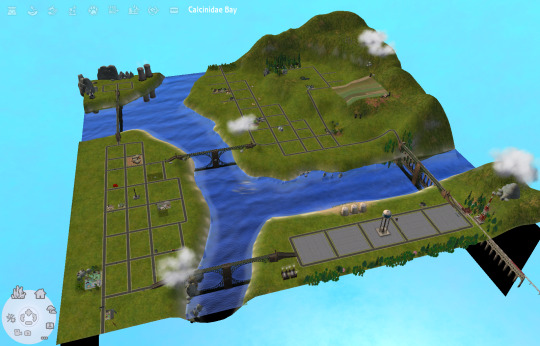
Calcinidae Bay is a(n unpopulated) work-in-progress CC-free Sims 2 neighbourhood where all the buildings are made from shell challenges.
I'm planning on posting more about Calcinidae Bay and its lots, so I wanted to make an intro post to start the tag! Feel free to mute the tag "Calcinidae Bay" if you're not interested.
Shell challenges are quite popular in the Sims 4, but they're possible to do in any Sims game and the principles are largely the same; one player puts down a bunch of walls, then other Simmers have to turn those walls into something without altering that "shell". Rules may vary depending on the creator and between game versions, but here are the general rules I'm playing by:
Walls that are already placed cannot be deleted, moved, or swapped with fences/half-walls.
New exterior walls cannot be connected to the the shell; they must be separated by at least one tile. This includes vertically (e.g. additional storeys, basements, dormers). New interior walls may be placed freely, but any preexisting interior walls must be preserved.
Fences and half-walls are allowed to be added/connected anywhere.
Foundation can be added freely but any existing foundation must be preserved (though it can be replaced with any of the 3 basegame foundation types).
There are some lots in Calcinidae Bay that don't follow these exact rules (such as my Foundations For Families houses) but do follow other building-restriction challenges, but the majority of lots are based on Sims 4 shell challenges converted to the Sims 2.
Let's take a look under the hood!

Calcinidae Bay is split into five sections, and has two roads leading in/out of town. Its terrain is Compass River by Leekeaux on MTS.
The blue/cyan area is the civic centre, where the entertainment, business, and government buildings are. There are some residential lots here, but mostly community. The road out leads to/from the future Downtown subhood.
The yellow section is the suburban area where most Sims live. It has a lot of housing, some smaller shops, and community lots like a library and public primary/secondary schools. The road out leads to/from the future Shopping District subhood.
The red/pink area is the rougher side of town. Since there are no roads out, there's less incidental traffic, so the real estate is less valuable and thus tends to be cheaper. This is where the remote offices, factories/warehouses, and affordable housing is/are.
The purple area is where the rich snobs live and gather. Houses here will be larger, older, and more expensive, and the few community lots will be more exclusive. (Note that "expensive" does not always mean "tasteful".)
Lastly, the green area in the corner is military ground. Eventually, it will have barracks, offices, and research facilities.
And if you were wondering, "why Calcinidae?" Well, Calcinidae is a family of hermit crabs - creatures that take shells left by others and repurpose them for their own use. :) The hermit crab and its shell are the coat of arms for Calcinidae Bay (and would be on its flag were I using custom content).
Most of the shells I use for Calcinidae Bay are remade from Sims 4 challenges, but I would love for Sims 2 players to donate shells too! Feel free to send me a Sims2Pack of a packaged shell OR simply draw the floorplan out on a grid and I'll remake it myself. You can also include other rules/suggestions about what the lot should be, what objects must be used, etc.
Lastly, I can't promise how useful all the lots in Calcinidae Bay would be for other players, especially since shell challenges can result in some unintuitive floorplans, but if you would like any of them, simply ask and I will do my best to share them. :)
80 notes
·
View notes
Text
Fun thing I noticed in inscryption
So, when I was in geography we started learning about the 4 main types of industries. And I feel like it fits the four Scrybes PERFECTLY.
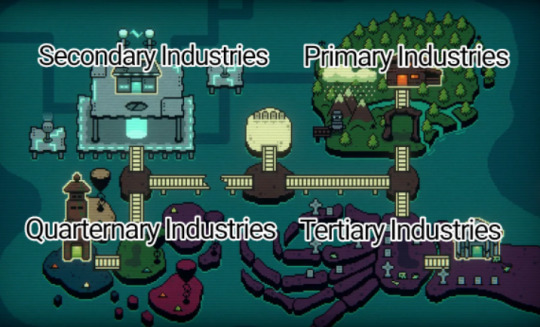
Get ready for my nerd rambling, because I have a lot to say.
So, there are like 4 types of industries. The first type is called primary industries. They are industries where the product is resources taken from the earth. Fishing and mining are good examples. Which is exactly why I think it fits Leshy so well. Literally, the angler if a fisherman, prospector is a miner, and the pelt making man (I forgot his name) collects fur.
The second type of industry takes the resources from the primary industries and shapes them into something new. So basically all manufacturing. The dredger literally takes random trash from the ocean, the melter forms them into different shapes, and the inspector inspects them.
The third type of industry is all things service. So like your doctors, cashiers, customer service, and funeral directors (Cough cough Grimora cough cough). Most jobs people work in are service jobs now, because it usually requires less education and is actually very important. Respect customer service, people! They do so much for us.
Lastly, we have the 4th type industry. This one is actually a type of service, but is so important that it has it's own section. And it's also very new. This industry the collection and sharing of information. So like researching, most lab jobs, and education. Which is exactly why magnificus is the 4th industry, because he shares information on how to work with magic to his poor pupils.
So yeah, that's my random nerd ramble. Honestly, imagine how cool inscryption would be if all four of them just worked together. I mean, literally the way their world works is built off each other in an economic way, too. I doubt Daniel mullens intended on the similarities between the four Scrybes and the four types of industry, but it works like soooo well.
#idk how to tag this#inscryption#economic geography#video game analysis#p03#leshy#grimora#magnificus#inscryption p03#inscryption magnificus#inscryption grimora#inscryption leshy#industries#media analysis#character analysis#??? idk#nerd rambles
75 notes
·
View notes
Text
What’s an acceptable tip for a driver who delivers a $20 pizza?
A TikTok video purporting to show a DoorDash delivery driver in Texas swearing at a customer over the $5 tip she gave him has gone viral, sparking fresh online debate over tipping culture in the U.S.
“I just want to say it’s a nice house for a $5 tip,” the driver can be heard saying as he walks away from a home in the door camera video posted to TikTok earlier this week by a user under the name Lacey Purciful.
“You’re welcome!” the resident says, appearing surprised by the remark. “F--- you,” the driver responds before walking away.
“So how much should I be tipping for a $20 pie?” Purciful, who, in a separate post said she herself has worked in the service industry for over 10 years and tips “very well,” wrote in a caption.
Purciful, who did not immediately respond to an overnight request for comment from NBC News, said the driver was fired by DoorDash following the incident.
A DoorDash spokesperson confirmed that the worker had been removed from their platform. They said the company had also reached out to the customer regarding the incident.
“Respectfully asking for a tip is acceptable but abusing or harassing someone is never acceptable,” the spokesperson said.
“Our rules exist to help ensure everyone who uses our platform — Dashers, customers, merchants — have a safe and enjoyable experience,” they said. “We expect everyone to treat others with respect and we will enforce our rules fairly and consistently.”
The video added fuel to a growing debate in the U.S. over tipping culture, with some complaining current trends may have reached a tipping point.
“Tipping is out of control,” one social media user said, commenting on the video. They said they felt $5 for a $20 order was “more than” enough.”
“I doordash and most (not all) pizza delivery orders don’t tip. That was a Rockstar tip,” another user said.
Not everyone agreed, however, with some branding Purciful a “Karen” for contacting DoorDash over the incident.
One poster said they felt the driver should not have lost their job over the exchange, writing: “What he said was not right, but he didn’t have to lose job over it. Everyone is trying to make a living.”
Another commenter noted that the driver may have been concerned about mileage, writing: “Maybe $5 wasn’t enough.”
The COVID-19 pandemic brought consumer willingness to give tips, particularly during times of hardship, into fresh focus, with many ponying up to pay higher gratuities during the crisis, according to research.
Figures provided earlier this year to NBC News by payment processor Square showed the frequency of gratuities at full-service restaurants grew 17% in the fourth quarter last year from the same period in 2021. Meanwhile, tip frequency at quick-service restaurants, such as coffee shops and fast-food chains, rose 16%, according to the company’s data.
The apparent rise in tipping came despite a period of record inflation, which has eaten away at many consumers’ discretionary income.
While the pandemic appeared to spur widespread changes in tipping culture, the growing use of point-of-service, or POS systems, to process payments also appear to have made it easier than ever for customers to provide — and for businesses to ask for — tips.
In a survey of restaurant executives by industry group Hospitality Technology, 71% of respondents said using data to “understand guest preferences and behavior” was their primary reason for facilitating POS system upgrades, while for 57% enabling new payment options was the priority.
A recent Lending Tree survey found that 60% of Americans felt they were tipping more, NBC Boston reported. Around 24% said they felt pressured to tip when the option was presented, while 41% said they had changed their buying habits due to gratuity expectations and 60% felt tipping expectations had gotten out of hand.
_________________
Door dash fired him, your opinion on tips aside that's not how you act to customers unless they are directly rude to you.
156 notes
·
View notes
Text
ASTRO 101 - THE HOUSES (PART I)
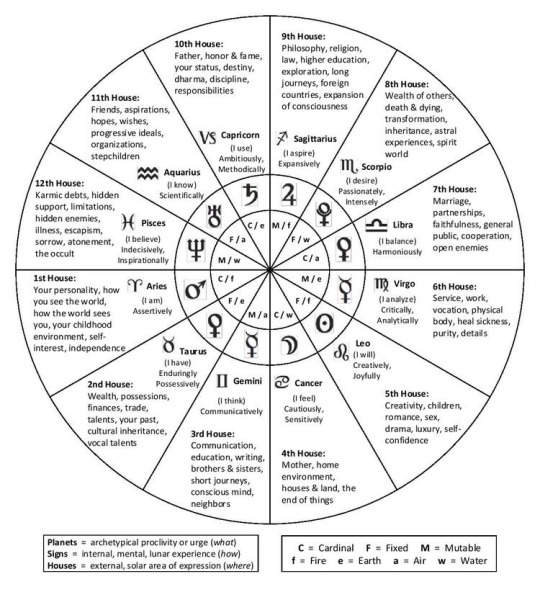
FIRST HOUSE - I AM
(The First House is ruled by Aries and Mars.)
The first moment you open your eyes to the world, first breath, first sight, first intention and first experience
General appearance, form and shape, physical body, general health, vitality and energy, action
Character, identity, self image, personality, mask, self interest, how others perceive you, self expression, independence, behavior, name, attitude, fame
How you see the world, how the world sees you
Spirit, life, ego, soul body
First impressions, beginnings
Head, face, eyes, blood, brain, muscular system
The moment of birth and people around you, place of birth and atmosphere, birth experiences, mother’s health and experiences during childbirth
SECOND HOUSE - I HAVE
(The Second House is ruled by Taurus and Venus.)
Material and non-material resources, attitude toward possessions,
How you make money or meet obligations, self worth
Personal finances, money matters, sense of value, stocks and share, trade, jewelry, documents, cash money, valuables, wealth, possessions, trade, material possessions, luxuries, banking activities, loans, economic situation, wares, rank, guarantee, financial security, artworks
Talents, comfort zone, security, self esteem, valuables, sense of values, resourcefulness, nutrition
Face, neck, throat, vocal cords, thyroid, metabolic system, voice and vocal talents
Economy, sovereign debt, colonies, fees, trade, banks, internal debts, artistic approaches of a country
THIRD HOUSE - I THINK
(The Third House is ruled by Gemini and Mercury.)
Conscious mind, memory, mental confusion, communication, intellect, mentation, thinking
Skillfulness, study, ability, writing, speaking, researching, learning, reading, perceiving, adaptability, ability to learn foreign languages
Depthless thoughts and informations, smattering
Elementary and primary education, puberty
Siblings, brothers, sisters, cousins, close relatives and neighbors
Short trips, tour, daily travel, neighborhood, public transports, vehicles, motorbike, cars, train, bus, boats, urban roads
TV, radio, telephone, computer, mails, messages, text, communication network and channels, short correspondence on social media, weather forecast
Shoulders, collar bone, arms, hands, fingers, lungs, nerves, the nervous system
Bookstore, library, school, post office, educational institution, streets, telephone kiosk
FOURTH HOUSE - I FEEL
(The Fourth House is ruled by Cancer and Moon.)
The place where we live with the family, home atmosphere, home life, house, mother, family, lineage, family matters, ancestry, custom, femininity
Subconscious, things we hide about ourselves, emotional problems, early childhood, depression, personal commitment, the deepest and the darkest point of the chart
Old age, the end of the life, diseases, grave
Land, realty, genetic heritage, underground sources
Chest, breaths, stomach, uterus, diaphragm, upper alimentary system
Agricultural enterprise, historical values, mining site, real estate, refuge facilities, farmers, cemeteries
FIFTH HOUSE - I WILL
(The Fifth House is ruled by Leo and Sun.)
Actions and activities we do for ourselves, things we like to do, hobbies, how do we spend our free time, creativity, activities we enjoy, pleasure, self expression, risk taking, leisure time, artistic talents,
Love, romance, dating, courtship, love affairs, the way we flirt
Children, birthing and creation, the character of our children
Acting, drama, dance, music, sports, artists, celebrities, stage
Games, cards, puzzles, fun, amusement, games of chance, gambling, speculative investment
Chest, upper back, heart, spine, cardiac system
Hotels, entertainment centers, casino, beauty shops, coiffeur, resort, amusement park, cinema, theatre, sports center, park, art exhibition
SIXTH HOUSE - I ANALYZE
(The Sixth House is ruled by Virgo and Mercury.)
What we do to survive, daily work, everyday routine, details, skills
Work routines, where we specialize our skills, workers, competition, employment, workmates
House of sickness, exhaustion, disease, allergies, health, physical body, physical condition
Issues that tire us and weaken us, drugs and addictions
Pets and animals
Abdomen, intestines, lower liver, alimentary canal, spleen, digestive nerves
Hospitals, health care providers, employees, service sector, trade unions, state employees, restaurants, food and beverage services, enemies, soldiers, police, military, army, security guard, navy, animal clinic

#astrology#aesthetic#birth chart#astro notes#astroblr#astroloji#astro natal#astro101#zodiac#horoscope#firsthouse#second house#third house#fourth house#fifth house#sixth house#astro houses#aries#taurus#gemini#cancer#leo#virgo#astrology blog#girlblogger#mars#venus#mercury#moon#zodiac signs
210 notes
·
View notes
Text
Ko-fi prompt from @thisarenotarealblog:
There's a street near me that has eight car dealerships all on the same lot- i counted. it mystifies me that even one gets enough sales to keep going- but 8?? is there something you can tell me that demystifies this aspect of capitalism for me?
I had a few theories going in, but had to do some research. Here is my primary hypothesis, and then I'll run through what they mean and whether research agrees with me:
Sales make up only part of a dealership's income, so whether or not the dealership sells much is secondary to other factors.
Dealerships are put near each other for similar reasons to grouping clothing stores in a mall or restaurants on a single street.
Zoning laws impact where a car dealership can exist.
Let's start with how revenue works for a car dealership, as you mentioned 'that even one gets enough sales to keep going' is confusing. For this, I'm going to be using the Sharpsheets finance example, this NYU spreadsheet, and this Motor1 article.
This example notes that the profit margin (i.e. the percentage of revenue that comes out after paying all salaries, rent, supply, etc) for a car dealership is comparatively low, which is confirmed by the NYC sheet. The gross profit margin (that is to say, profits on the car sale before salaries, rent, taxes) is under 15% in both sources, which is significantly lower than, say, the 50% or so that one sees in apparel or cable tv.
Cars are expensive to purchase, and can't be sold for much more than you did purchase them. However, a low gross profit margin on an item that costs tens of thousands of dollars is still a hefty chunk of cash. 15% gross profit of a $20,000 car is still $3,000 profit. On top of that, the dealership will charge fees, sell warranties, and offer upgrades. They may also have paid deals to advertise or push certain brands of tire, maintenance fluids, and of course, banks that offer auto loans. So if a dealership sells one car a day, well, that's still several thousand dollars coming in, which is enough to pay the salaries of most of the employees. According to the Motor1 article, "the average gross profit per new vehicle sits at $6,244" in early 2022.
There is also a much less volatile, if also much smaller, source of revenue in attaching a repairs and checkup service to a dealership. If the location offers repairs (either under warranty or at a 'discounted' rate compared to a local, non-dealership mechanic), state inspections, and software updates, that's a recurring source of revenue from customers that aren't interested in purchasing a car more than once a decade.
This also all varies based on whether it's a brand location, used vs new, luxury vs standards, and so on.
I was mistaken as to how large a part of the revenue is the repairs and services section, but the income for a single dealership, on average, does work out math-wise. Hypothesis disproven, but we've learned something, and confirmed that income across the field does seem to be holding steady.
I'm going to handle the zoning and consolidation together, since they overlap:
Consolidation is a pretty easy one: this is a tactic called clustering. The expectation is that if you're going to, say, a Honda dealership to look at a midsize sedan, and there's a Nissan right next door, and a Ford across the street, and a Honda right around the corner, you might as well hit up the others to see if they have better deals. This tactic works for some businesses but not others. In the case of auto dealerships, the marketing advantage of clustering mixes with the restrictions of zoning laws.
Zoning laws vary by state, county, and township. Auto dealerships can generally only be opened on commercially zoned property.
I am going to use an area I have been to as an example/case study.
This pdf is a set of zoning regulations for Suffolk County, New York, published 2018, reviewing land use in the county during 2016. I'm going to paste in the map of the Town of Huntington, page 62, a region I worked in sporadically a few years ago, and know mostly for its mall and cutesy town center.
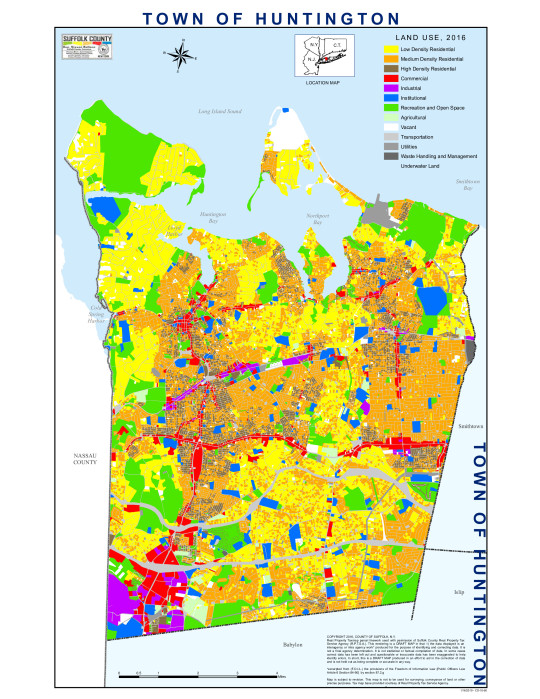
Those red sections are Commercially Zoned areas, and they largely follow some large stroads, most notably Jericho Turnpike (the horizontal line halfway down) and Walt Whitman Road (the vertical line on the left). The bulge where they intersect is Walt Whitman Mall, and the big red chunk in the bottom left is... mostly parking. That central strip, Jericho Turnpike, and its intersection with Walt Whitman... looks like this:

All those red spots are auto dealerships, one after another.
So zoning laws indicate that a dealership (and many other types of commercial properties) can only exist in that little red strip on the land use map, and dealerships take up a lot of space. Not only do they need places to put all of the cars they are selling, but they also need places to park all their customers and employees.
This is where we get into the issue of parking minimums. There is a recent video from Climate Town, with a guest spot by NotJustBikes. If you want to know more about this aspect of zoning law, I'd recommend watching this video and the one linked in the description.
Suffolk county does not have parking minimums. Those are decided on a town or village level. In this case, this means we are looking at the code set for the town of Huntington. (I was originally looking on the county level, and then cut the knot by just asking my real estate agent mom if she knew where I could find minimum parking regulations. She said to look up e360 by town, and lo and behold! There they are.)
(There is also this arcgis map, which shows that they are all within the C6 subset of commercial districting, the General Business District.)
Furniture or appliance store, machinery or new auto sales
- 1 per 500 square feet of gross floor area
Used auto sales, boat sales, commercial nurseries selling at retail
- 5 spaces for each use (to be specifically designated for customer parking)
- Plus 1 for each 5,000 square feet of lot area
This is a bit odd, at first glance, as the requirements are actually much lower than that of other businesses, like drive-in restaurants (1 per 35 sqft) or department stores (1 per 200 sqft). I could not find confirmation on whether the 'gross floor area' of the dealership included only indoor spaces or also the parking lot space allotted to the objects for sale, but I think we can assume that any parking spaces used by merchandise do not qualify as part of the minimum. Some dealerships can have up to 20,000 gross sqft, so those would require 40 parking spaces reserved solely for customers and employees. Smaller dealerships would naturally need less. One dealership in this area is currently offering 65 cars of varying makes and models; some may be held inside the building, but most will be on the lot, and the number may go higher in other seasons. If we assume they need 30 parking spaces for customers and employees, and can have up to 70 cars in the lot itself, they are likely to have 100 parking spaces total.
That's a lot of parking.

Other businesses that require that kind of parking requirement are generally seeing much higher visitation. Consider this wider section of the map:

The other buildings with comparative parking are a grocery store (Lidl) and a post office (can get some pretty high visitation in the holiday season, but also just at random).
Compare them, then, to the "old town" section of the same town.
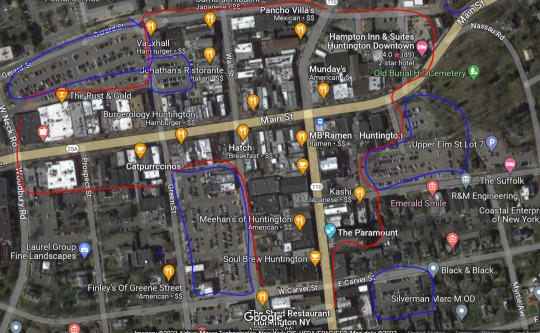
There are a handful of public parking areas nearby (lined in blue), whereas the bulk of the businesses are put together along this set of streets. While there is a lot of foot traffic and vehicle passage, which is appealing for almost any business, opening a car dealership in this area would require not only buying a building, but also the buildings surrounding it. You would need to bulldoze them for the necessary parking, which would be prohibitively expensive due to the cost of local real estate... and would probably get shot down in the application process by city planners and town councils and so on. Much easier to just buy land over in the strip where everyone's got giant parking lots and you can just add a few extra cramped lanes for the merchandise.
Car dealerships also tend to be very brightly lit, which hits a lot of NIMBY sore spots. It's much easier to go to sleep if you aren't right next to a glaring floodlight at a car dealership, so it's best if we just shove them all away from expensive residential, which means towards the loud stroads, which means... all along these two major roads/highways.
And if they're all limited to a narrow type of zoning already, they might as well take advantage of cluster marketing and just all set up shop near each other in hopes of stealing one of the other's customers.
As consumers, it's also better for us, because if we want to try out a few different cars from a few different brands, it's pretty easy to just go one building down to try out the Hyundai and see if it's better than a Chevy in the same price group.
(Prompt me on ko-fi!)
#economics prompts#marketing#zoning laws#ko fi prompts#ko fi#auto industry#automotive dealerships#car dealerships#phoenix posts
110 notes
·
View notes
Note
Romantic/Platonic Chol 'Von (Halo) with a human trader darling, who lives on one of the colonies that does unsavory business with pirates like her. Don't care which format, whichever is easiest to write.
I'm going to be honest, I've never read Mortal Dictata or any of the Kilo-Five books yet. However, I did do my research on the character so I hope I get her character right. Sorry for any inaccuracies! As a result this may be short. When I find time to read the book maybe I'll rewrite this, I'm happy to take feedback!
Yandere! Chol 'Von with Human Trader! Darling
(Halo: Mortal Dictata)
Pairing: Romantic/Platonic
Possible Trigger Warnings: Gender-Neutral Darling, Obsession, Manipulation, Possessive behavior, Violence, Threats, Dubious companionship.

I wouldn't doubt Chol comes in contact with human traders.
With her ambitious goals and fondness towards human phrases and ideologies it isn't too far off to think she'd buy from you.
She needs supplies for her Kig-Yar navy and Kig-Yar have been known to ally with humans if it benefits them.
To you, Chol is merely a client when she visits your colony to discuss affairs.
She feels like an egotistical shipmistress T'vaoan Kig-Yar who enjoys intimidation.
Chol is also easily impatient and temperamental, very quick to be stressed when things don't go her way.
She's been known to be persistent in her goals and is stubborn.
To make some money you trade with her.
It isn't too new to you, you've traded with Kig-Yar and Sangheili in the past.
Yet this one is important... she's a feared shipmistress and knows it.
You've heard vaguely in Kig-Yar culture that females of the species tend to have a lot of power.
As a result you are always very respectful in your deals.
You supply fuel, weapons, all sorts of cargo.
In return you're given other valuable items or some sort of currency in return.
You're just in it for the connections and money.
Kig-Yar are pirates... but you feel they can be good allies if you provide them what they like.
Which is what Chol likes about you.
She likes your human ideologies and picks up certain phrases and info about you.
You aren't part of any major faction... just a human trying to get by.
In a way she relates due to her species culture.
Chol sees you as the key to seeing her goals through.
With your wares she can make that navy she wanted and maybe even convince the other Kig-Yar to listen to her.
Chol is more likely to be a platonic yandere to her new favorite trader.
However... toying with the romantic idea is a bit interesting albeit not plausible.
After all... she sees her current mate as a coward who fled from her and her chicks.
Maybe a human will provide much better... even if nothing can happen between you.
Chol is demanding towards you at times due to her egotistical nature.
It's an honor to help her as a human.
She respects you and is a fearsome T'vaoan shipmistress.
Can't you see you're special if she's interacting with you?
Having her as your ally will make you strong and protected.
So you better keep providing for her, yeah?
In fact... you only need her as your customer... she'll give you much better equipment in return for your services.
Her ego is definitely what makes her try to control you.
She promises you good things in return if you just make her your primary client.
If you don't do so willingly... she can threaten you.
Do you doubt her? She could cause so much trouble for you if you refuse her.
Chol feels she can control you.
After all she often boasts that she can get whatever she wants.
Any mate, any valuable, anything.
If not... she doesn't mind the ensuing bloodshed.
So when she makes an offer with you... one that makes you loyal to her on one of her ships by her side and under her protection as her primary merchant/negotiater...
She expects you to accept when she tells you.
30 notes
·
View notes
Text
Kashmir Hill’s “Your Face Belongs to Us”

This Friday (September 22), I'm (virtually) presenting at the DIG Festival in Modena, Italy. That night, I'll be in person at LA's Book Soup for the launch of Justin C Key's "The World Wasn’t Ready for You." On September 27, I'll be at Chevalier's Books in Los Angeles with Brian Merchant for a joint launch for my new book The Internet Con and his new book, Blood in the Machine.

Your Face Belongs To Us is Kashmir Hill's new tell-all history of Clearview AI, the creepy facial recognition company whose origins are mired in far-right politics, off-the-books police misconduct, sales to authoritarian states and sleazy one-percenter one-upmanship:
https://www.penguinrandomhouse.com/books/691288/your-face-belongs-to-us-by-kashmir-hill/
Hill is a fitting chronicler here. Clearview first rose to prominence – or, rather, notoriety – with the publication of her 2020 expose on the company, which had scraped more than a billion facial images from the web, and then started secretly marketing a search engine for faces to cops, spooks, private security firms, and, eventually, repressive governments:
https://www.nytimes.com/2020/01/18/technology/clearview-privacy-facial-recognition.html
Hill's original blockbuster expose was followed by an in-depth magazine feature and then a string more articles, which revealed the company's origins in white nationalist movements, and the mercurial jourey of its founder, Hoan Ton-That:
https://www.nytimes.com/interactive/2021/03/18/magazine/facial-recognition-clearview-ai.html
The story of Clearview's technology is an interesting one, a story about the machine learning gold-rush where modestly talented technologists who could lay hands on sufficient data could throw it together with off-the-shelf algorithms and do things that had previously been considered impossible. While Clearview has plenty of competitors today, as recently as a couple of years ago, it played like a magic trick.
That's where the more interesting story of Clearview's founding comes in. Hill is a meticulous researcher and had the benefit of a disaffected – and excommunicated – Clearview co-founder, who provided her with masses of internal communications. She also benefited from the court documents from the flurry of lawsuits that Clearview prompted.
What emerges from these primary sources – including multiple interviews with Ton-That – is a story about a move-fast-and-break-things company at the tail end of the forgiveness-not-permission era of technological development. Clearview's founders are violating laws and norms, they're short on cash, and they're racing across the river on the backs of alligators, hoping to reach the riches on the opposite bank without losing a leg.
A decade ago, they might have played as heroes. Today, they're just grifters – bullshitters faking it until they make it, lying to Hill (and getting caught out), and the rest of us. The founders themselves are erratic weirdos, and not the fun kind of weirdos, either. Ton-That – who emigrated to Silicon Valley from Australia as a teenager, seeking a techie's fortune – comes across as a bro-addled dimbulb who threw his lot in with white nationalists, MAGA Republicans, Rudy Guiliani bagmen, Peter Theil, and assorted other tech-adjascent goblins.
Meanwhile, biometrics generally – and facial recognition specifically – is a discipline with a long and sordid history, inextricably entwined with phrenology and eugenics, as Hill describes in a series of interstitial chapters that recount historical attempts to indentify the facial features that correspond with criminality and low intelligence.
These interstitials are woven into a-ha moments from Clearview's history, in which various investors, employees, hangers-on, competitors and customers speculate about how a facial-recognition system could eventually not just recognize criminals, but predict criminality. It's a potent reminder of the AI industry's many overlaps with "race-science" and other quack beliefs.
Hill also describes how Clearview and its competitors' recklessness and arrogance created the openings for shrewd civil libertarians to secure bipartisan support for biometric privacy laws, most notably Illinois' best-of-breed Biometric Information Privacy Act:
https://www.ilga.gov/legislation/ilcs/ilcs3.asp?ActID=3004&ChapterID=57
But by the end of the book, Hill makes the case that Ton-That and his competitors have gotten away with it. Facial recognition is now so easy to build that – she says – we're unlikely to abolish it, despite all the many horrifying ways that FR could fuck up our societies. It's a sobering conclusion, and while Hill holds out some hope for curbing the official use of FR, she seems resigned to a future in which – for example – creepy guys covertly snap photos of women on the street, use those pictures to figure out their names and addresses, and then stalk and harass them.
If she's right, this is Ton-That's true legacy, and the legacy of the funders who handed him millions to spend building this. Perhaps someone else would have stepped into that sweaty, reckless-grifter-shaped hole if Ton-That hadn't been there to fill it, but in our timeline, we can say that Ton-That was the bumbler who helped destroy something precious.



If you'd like an essay-formatted version of this post to read or share, here's a link to it on pluralistic.net, my surveillance-free, ad-free, tracker-free blog:
https://pluralistic.net/2023/09/20/steal-your-face/#hoan-ton-that

#pluralistic#books#reviews#gift guide#clearview ai#facial recognition#biometrics#eugenics#crime#privacy#cop shit#hoan ton-that
84 notes
·
View notes
Text
30 ways to make real; money from home
Making money online from the comfort of your home has become increasingly accessible with the growth of the internet and digital technologies. In 2023, there are numerous realistic ways to earn money online. Here are 30 ideas to get you started:
1. Freelance Writing: Offer your writing skills on platforms like Upwork or Freelancer to create blog posts, articles, or website content.
2. Content Creation: Start a YouTube channel, podcast, or blog to share your expertise or passion and monetize through ads, sponsorships, and affiliate marketing.
3. Online Surveys and Market Research: Participate in online surveys and market research studies with platforms like Swagbucks or Survey Junkie.
4. Remote Customer Service: Work as a remote customer service representative for companies like Amazon or Apple.
5. Online Tutoring: Teach subjects you're knowledgeable in on platforms like VIPKid or Chegg Tutors.
6. E-commerce: Start an online store using platforms like Shopify, Etsy, or eBay to sell products.
7. Affiliate Marketing: Promote products or services on your blog or social media and earn commissions for sales made through your referral links.
8. Online Courses: Create and sell online courses on platforms like Udemy or Teachable.
9. Remote Data Entry: Find remote data entry jobs on websites like Clickworker or Remote.co.
10. Virtual Assistance: Offer administrative support services to businesses as a virtual assistant.
11. Graphic Design: Use your graphic design skills to create logos, graphics, or websites for clients on platforms like Fiverr.
12. Stock Photography: Sell your photos on stock photography websites like Shutterstock or Adobe Stock.
13. App Development: Develop and sell mobile apps or offer app development services.
14. Social Media Management: Manage social media accounts for businesses looking to enhance their online presence.
15. Dropshipping: Start an e-commerce business without holding inventory by dropshipping products.
16. Online Consultations: Offer consulting services in your area of expertise through video calls.
17. Online Surplus Sales: Sell unused items or collectibles on platforms like eBay or Facebook Marketplace.
18. Online Fitness Coaching: Become an online fitness coach and offer workout plans and guidance.
19. Virtual Events: Host webinars, workshops, or conferences on topics you're knowledgeable about.
20. Podcast Production: Offer podcast editing, production, or consulting services.
21. Remote Transcription: Transcribe audio and video files for clients.
22. Online Translation: Offer translation services if you're proficient in multiple languages.
23. Affiliate Blogging: Create a niche blog with affiliate marketing as the primary revenue source.
24. Online Art Sales: Sell your artwork, crafts, or digital art on platforms like Etsy or Redbubble.
25. Remote Bookkeeping: Offer bookkeeping services for small businesses from home.
26. Digital Marketing: Provide digital marketing services like SEO, PPC, or social media management.
27. Online Gaming: Stream your gaming sessions on platforms like Twitch and monetize through ads and donations.
28. Virtual Assistant Coaching: If you have experience as a VA, offer coaching services to aspiring virtual assistants.
29. Online Research: Conduct research for businesses or individuals in need of specific information.
30. Online Real Estate: Invest in virtual real estate, such as domain names or digital properties, and sell them for a profit.
Remember that success in making money online often requires dedication, patience, and the ability to adapt to changing trends. It's essential to research and choose the opportunities that align with your skills, interests, and long-term goals.
#founder#accounting#ecommerce#copywriting#business#commercial#economy#branding#entrepreneur#finance#make money online#earn money online#make money from home#old money#i turn to these cute#disgraced youtuber ruby franke#my mum#money#claims shock report#says terrified brit#easy money
56 notes
·
View notes
Text




Questions You Need to Answer as a Business Owner/ Start Up Founder
Here’s a list of questions you should be able to answer while preparing for a client call, investor meeting or presentation.
- Have you conducted customer research? What was the outcome?
- What was a lesson you learned along the way?
- How do you develop product strategy?
- Who is your primary customer?
- If most of your business is partnership based; What drop rate are you expecting when your trial/ pilot with these partnerships is over?
- How much risk does your distribution strategy have?
- How easily can your competition replicate you?
- How easy or expensive is it for your customers to switch to your competition instead of you?
- What are some major barriers you’re expecting?
- what KPIs are you expecting from your pilot? Which one are you going to focus deeply on?
- What is your burn rate?
- Talk about your unit economics a little more.
- Are you focused on growth or profitability?
- How can you achieve break even faster?
- What’s your current cap table?
- What will you do if your top line don’t match expectations?
- What is your vision?
#c suite#powerful woman#ceo aesthetic#personal growth#that girl#productivity#strong women#getting your life together#feminine energy#balance#start up#business owner#founder#co founder#unicorns#questions#investors#clients#partnerships#things to know#hustle#grind#entrepreneurship#entreprenuerlife#hustler
468 notes
·
View notes
Text
What are Fibroblast Cells?
he pig genome is three times closer to our genome that that of mice. Take the example of cystic fibrosis, the introduction of the mutation responsible for the disease in mice has not shown the exact course of the disease however, recent reports show the successful recapitulation of the disease in pig models. As there is a similarity between the cardiovascular system, the gastrointestinal tract, and the pancreas between pigs and humans, research on diseases and toxicology can be carried out on these models with Swine Fibroblast Cells (Walters et al, 2013).
#pig cell#fibroblast cells#pig stem cells#porcine cells#pig cells#what are fibroblast cells#what type of cells are fibroblasts#pig dna vs human dna#human and pig dna similarity#Cell culture#customized primary cells#primary cells#biotech company#stem cells#exosomes#stem cell research center#regenerative medicine#bioengineering#Kosheeka
0 notes
Text
Musings on Sharlayan Fashion(?)
A series of observations on Sharlayan dress and colour.
I find the variations of the Shire sets worn by Sharlayan scholars and researchers presented in Old Sharlayan and Labyrinthos to be fascinating, so I thought I'd put together my thoughts and findings! This will be an image heavy post to contain all of the screenshot references so I will place the majority of it below a cut. We're in for a ride.

My general point here is that the colour theming of Sharlayan outfits are a uniform which denotes one's specialty or field of study. What follows are what I would consider to be confirmed lines of work/study. Let's start off with likely the most familiar colour variant, which I will call:
Aetherite Nerds - Cactuar Green
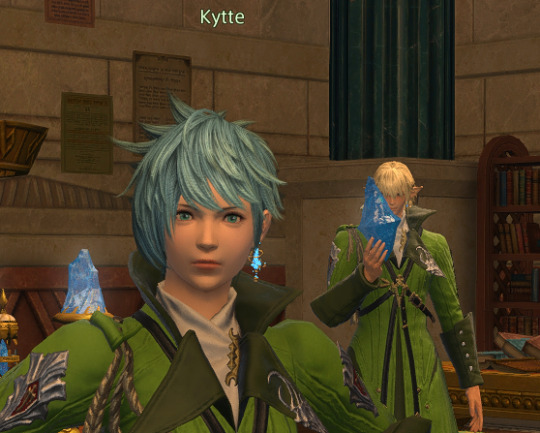
We're familiar with these vibrant green specialists for their assistance reaching Thavnair via their experimental unattuned aetherite in the Confluence, but there are a couple more hanging out in the Archon's Den area.
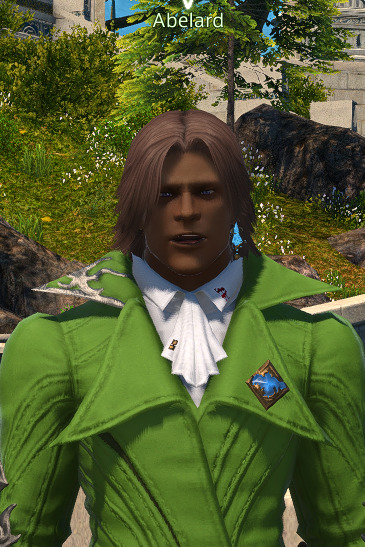

Up next, another familiar sight from the Studium:
The Faculty (Materials Nerds) - Canary Yellow

You may have noticed these banana friends at the scrip exchange, but their primary interests seem to be with the procurement of specialized materials and supporting the material needs of the Studium at large as displayed with Qih's introduction to Studium DoH/DoL quests and Edithe's efforts to to inform us on hunt targets as a Gleaner ourselves.
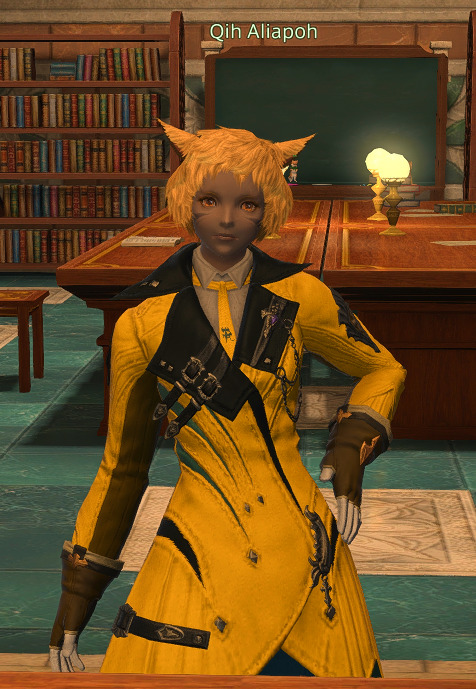
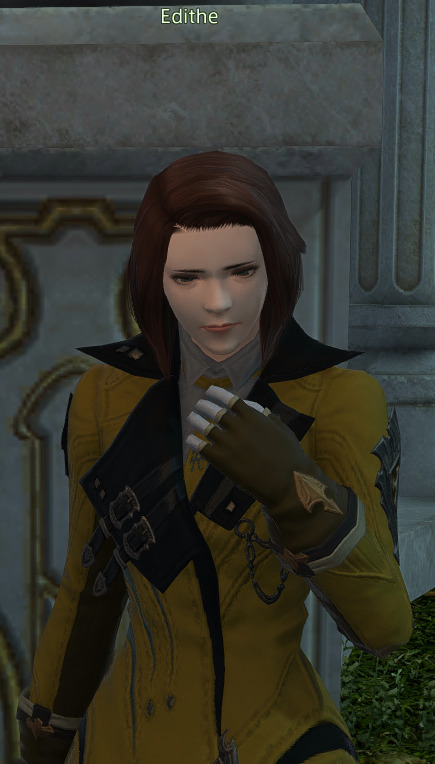

Our next subjects are likely one of the most numerous:
Customs and Public Transit - Ice Blue




Once you've noticed them, you'll see these ones everywhere. Every lift in Labyrinthos is staffed with these blue garbed officials.
Materia Nerds - Rolanberry Red

Pretty self explanatory, but at least one more with this colour can be seen as part of the random wandering NPCs in the Agora and speaks directly of Master Mutamix.
Rostra Guards - Ochu Green


Somewhat unique in the way that these two openly carry swords, they guard the entrance to the Rostra and thereby the Forum. Important job! Probably!
From here we venture into speculation, but let's start with what I think is most likely.
Preceptors - White
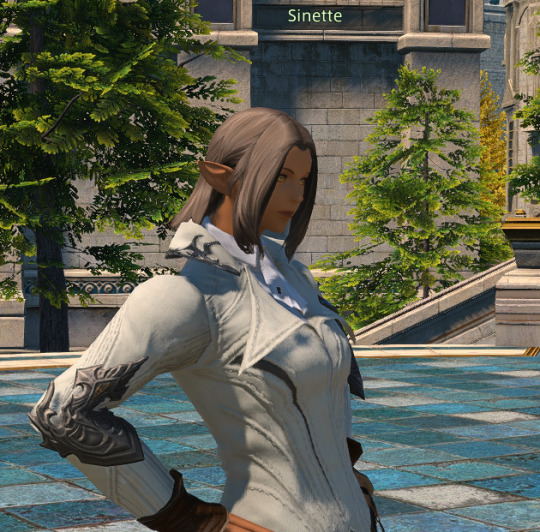


The white garb is fairly common, but my observations lend it to no particular study. With a stretch, we could make an assumption that because the Shire Preceptor's Coat is a healing item that is connotes some relation to healing or a medical field and reinforce this with the observation that Y'shtola's Modish attire bears clear influences from it via the style of cut and red accents. However, I believe that it's prevalence hints more to the name itself - Preceptor, defined as a teacher or instructor. Plenty of those in Sharlayan to be sure!
Logistics? - Black



These are the only two I've found with distinctly black garb, and assume they have some association with the logistics support structure around the Gleaners given their dialogue with regards to specimens and cargo.
Curmudgeons - Anamnesis Variant Teal Collar

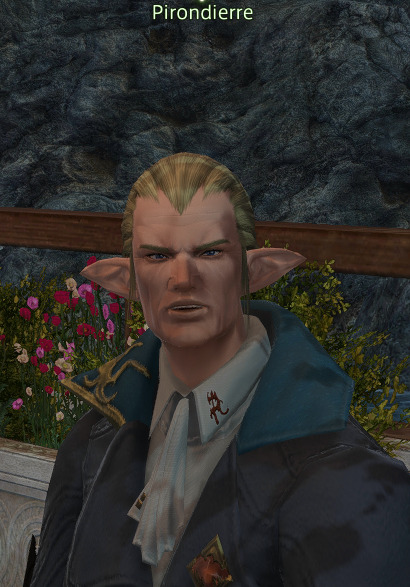


Both of these lads are ill tempered and both wear the variant of the Shire set unique to Anamnesis. Maybe they caught some grumpy old man energy from there by fashion osmosis?
Exceptions and Unknowns
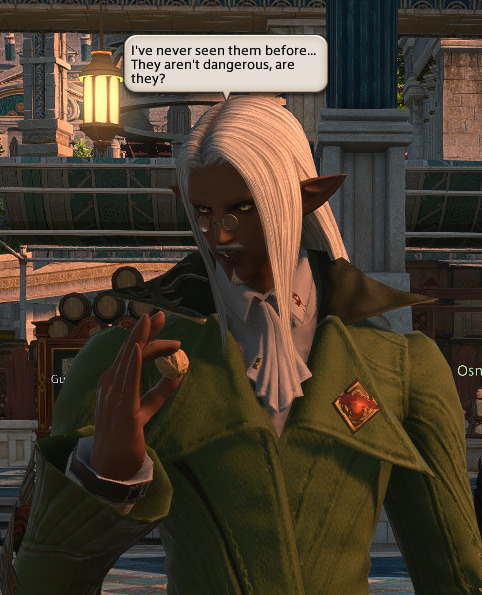



While we know from her quest that our most glorious sole Xaela representative of Sharlayan, Boragchin, is in charge of some carnivorous animals in Labyrinthos with her unique Void Blue (I think), there are several other colours that give no clear indication as to their field.
It is quite likely that I may have missed some that would clarify these chromatic aberrations or that we will see and know more in the future, but I hope this was insightful and/or helpful for your own scholar's wardrobe!
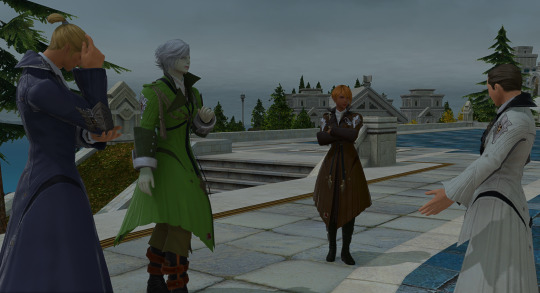
133 notes
·
View notes
Text
Business Model for
Stellar Charm:
Target Market: The target market for Stellar Charm will
be primarily young adults and teenagers
who are interested in strategy-based card games. The game will also appeal to astronomy enthusiasts and fans of fantasy and mythology.
Revenue Streams:
The primary source of revenue for Stellar Charm will be the sales of the game itself.
In addition, the game can generate revenue through expansion packs, limited edition cards, and merchandise such as t-shirts, posters, and figurines.
Distribution Channels: Stellar Charm will be sold through various distribution channels such as online marketplaces like Amazon and Etsy, as well as through brick and mortar stores specializing in board games and card games. The game will also be available for purchase directly from the company's website.
Marketing and Advertising: To reach the target market, Stellar Charm will utilize a mix of
digital and traditional marketing strategies. This will include
social media marketing, influencer partnerships, targeted online ads, and participation in gaming conventions and events. The game will also have a strong presence on popular gaming forums and communities.
Production and Manufacturing: The game will be produced and manufactured in-house to maintain quality control and minimize production costs. This will also allow for faster turnaround time for new expansions and updates.
Pricing Strategy: The price of the base game will be set at a competitive rate to attract customers. Expansion packs and limited edition cards will be priced slightly higher to appeal
to collectors and enthusiasts. Discounts and promotions will also be offered periodically to encourage sales.
Customer Support: Stellar Charm will have a dedicated customer support team to handle any queries or concerns from customers. This will ensure a positive customer experience
and help build brand loyalty.
Partnerships and Collaborations: In
order to increase brand awareness and reach a wider audience, Stellar Charm will collaborate with other popular games and brands. This can include cross-promotion, co-branded products, and special events.
Cost Structure: The main costs involved in running the business will include production and manufacturing
costs, marketing and advertising expenses, and operational
expenses such as rent, utilities, and salaries. The company will also invest in research
and development to continuously improve the game and create new expansions.
Future Plans: As the game gains popularity, the company can consider developing a digital version of Stellar Charm for mobile or computer platforms. This can open up new revenue streams and reach a larger audience. The company may also consider licensing the game to other countries to expand its market reach.
Play style
Card Name and Type: This feature displays the name of the battle card and its type, such as "Stellar Charm - Magical" or "Stellar Charm - Elemental". This helps the player identify the card and its category, which can be useful in planning their strategy.
Element: The
element of the card
is represented by a symbol or color and is crucial in determining its strengths and weaknesses. For example, a water element card
may be strong against fire but weak against lightning. The player must keep this in mind when using the card in battles.
Attack Points: This feature displays the attack points of the card, which represents its offensive power. The higher the attack points, the stronger the card's attack will be. The player can use this information to strategically choose when to use the card in battle.
Defense Points: The defense points of the card represent its defensive capabilities. The higher the defense points, the better the card can withstand attacks from the opponent. The player can use this feature to strategically defend against the opponent's attacks.
Special Ability: Some battle cards may have a special ability that can be activated during battle. This feature will describe the special ability, such as "Healing Aura" or "Double Attack",
and how it can be used in battle. The player must carefully consider when to use the special ability to gain an advantage over their opponent.
Fusion Requirements: The fusion requirements feature displays the elements or types of cards needed to fuse with the Stellar Charm card to create a more powerful card. This adds a layer of strategy to the game as the player must strategically choose which cards to fuse with the Stellar Charm card to create
the most advantageous outcome.
Lore: The lore of
the card provides a background story or description of the
card, which can help
the player understand the card's role in the game. This feature can also add an element of immersion and depth to the game, making it more engaging for the player.
The game would be called "Constellation Clash" and it would be a two-player strategy battle card game. The objective of the game would be to collect and control the most constellations by the end of the game.
Card Types:
Constellation Cards
These cards represent the 88 constellations and each one has its own unique abilities and strengths.
Zodiac Cards - These cards represent the
12 zodiac signs and
can be used to enhance the abilities of constellation cards.
Star Cards - These cards represent individual stars and can be used to boost the power of constellation cards.
Element Cards - These cards represent the four elements (fire, water, air, and earth) and
can be used to counter certain constellation cards.
Action Cards - These
cards have various
effects and can be used
to interrupt or change
the course of the game.
Card Styles:
Basic Cards - These
cards have a simple
design and represent
the less powerful
constellations.
Advanced Cards - These cards have a
more intricate design and represent the more powerful constellations.
Mythical Cards - These cards have a unique design and represent the rare and powerful constellations.
Gameplay:
Set-Up - Each player starts with a deck of 20 constellation cards, 10 zodiac cards, 10 star cards, and 5 element cards. Each player also starts with 5 action cards in their hand. The remaining action cards are placed in a separate deck.
Turn Sequence - The game is played in turns. Each turn, a player can perform the following actions in any order:
Play one constellation card from their hand onto the field.
Play one zodiac or star card from their hand onto the field,
and attach it to a
constellation card
already on the field.
Play one action card
from their hand and
resolve its effect.
Battle Phase - Once both players have finished their turns, a battle phase begins. The player who has the most stars attached to their constellation cards
has the first attack. Each player takes turns attacking and defending until all battles have been resolved.
Battle Rules - During a battle, the attacking player chooses one of their constellation cards to attack with. The defending player
can choose to block
the attack with one of their constellation cards or take the full damage. If the attack is blocked, the defender's constellation card is discarded. If the attack is not blocked, the defender takes damage equal to the difference between the attacking constellation card's power and the defending constellation card's power.
Element Advantage - Certain constellation cards have an advantage over others based on their element. If a constellation card with a higher element attacks a constellation card with a lower element, the attacking card's power is increased by 50%.
Mythical Card Rule
If a player has a mythical card on the field, they can choose to activate its special ability once per turn during the battle phase.
End of Turn - After
the battle phase, the
player can choose to
discard any cards from
their hand and draw new
ones, up to their hand
limit of 5 cards.
End of Game - The game ends when one player has control of at least 10 constellations or when one player runs out of cards in their deck. The player with the most constellations under their control wins the game.
The phases of the game would develop as players strategically play their cards, trying to gain control of the most powerful constellations and using their
zodiac and star cards strategically to enhance their abilities. The game would also require players to carefully manage their resources and choose when to use their action cards for maximum impact. With the mythical cards adding
an extra element of
surprise, every game
would be unique and
challenging.
Zodiac Cards: These are the most powerful and rare cards in the game, representing the 12 zodiac signs. Each Zodiac Card has a unique ability and high attack and defense points.
Star Cards: These cards represent the stars within each constellation and
are the backbone of
any deck. They have
a balanced mix of
attack and defense points and can be used strategically to support other cards.
Mythology Cards: These cards are based
on the ancient stories and myths associated with each constellation. They have powerful abilities that can turn the tide of battle, but are limited in number and should be used sparingly.
Elemental Cards: There are 4 elemental card types in the game - Fire, Water, Earth, and Air, each representing
a different element
from the universe.
These cards have a rock-paper-scissors relationship with each other, with one element being strong against another and weak against the third. They can
be used to counter opponent's cards and add an element of strategy to the game.
Celestial Cards: These cards represent celestial objects such as planets, comets, and galaxies. They have powerful abilities that can affect multiple cards at once, but are also limited in number and should be used strategically.
Constellation Cards: These cards represent the constellations themselves and have a unique ability that can only be activated when
a player has a certain number of cards from the same constellation in their hand.
Support Cards:
These cards do not
have any attack or defense points, but instead, provide support to other cards in a player's hand. They
can boost attack or defense points, provide additional abilities, or even revive defeated cards.
Card Styles:
Standard Cards: These cards have a simple design with the constellation name and image on the front and the card type and stats on the back.
Foil Cards: These
are rare and valuable versions of the standard cards, with a metallic sheen and enhanced artwork.
Holographic Cards: These cards have a holographic design that changes depending on the angle they are viewed from. They are highly sought after by collectors.
Legendary Cards: These are the most powerful and rare cards in the game, with unique artwork and abilities. They are highly coveted and can only be obtained through special events or by trading with other players.
Promo Cards: These limited edition cards are only available through special promotions, such as tournaments or special edition sets.
Prism Cards: These cards have a prism design that creates a rainbow effect when viewed under light. They are highly prized by players for their unique design.
Cosmic Cards: These cards have a cosmic design, with images of galaxies, stars, and other celestial objects. They are considered the most visually stunning cards in the game.
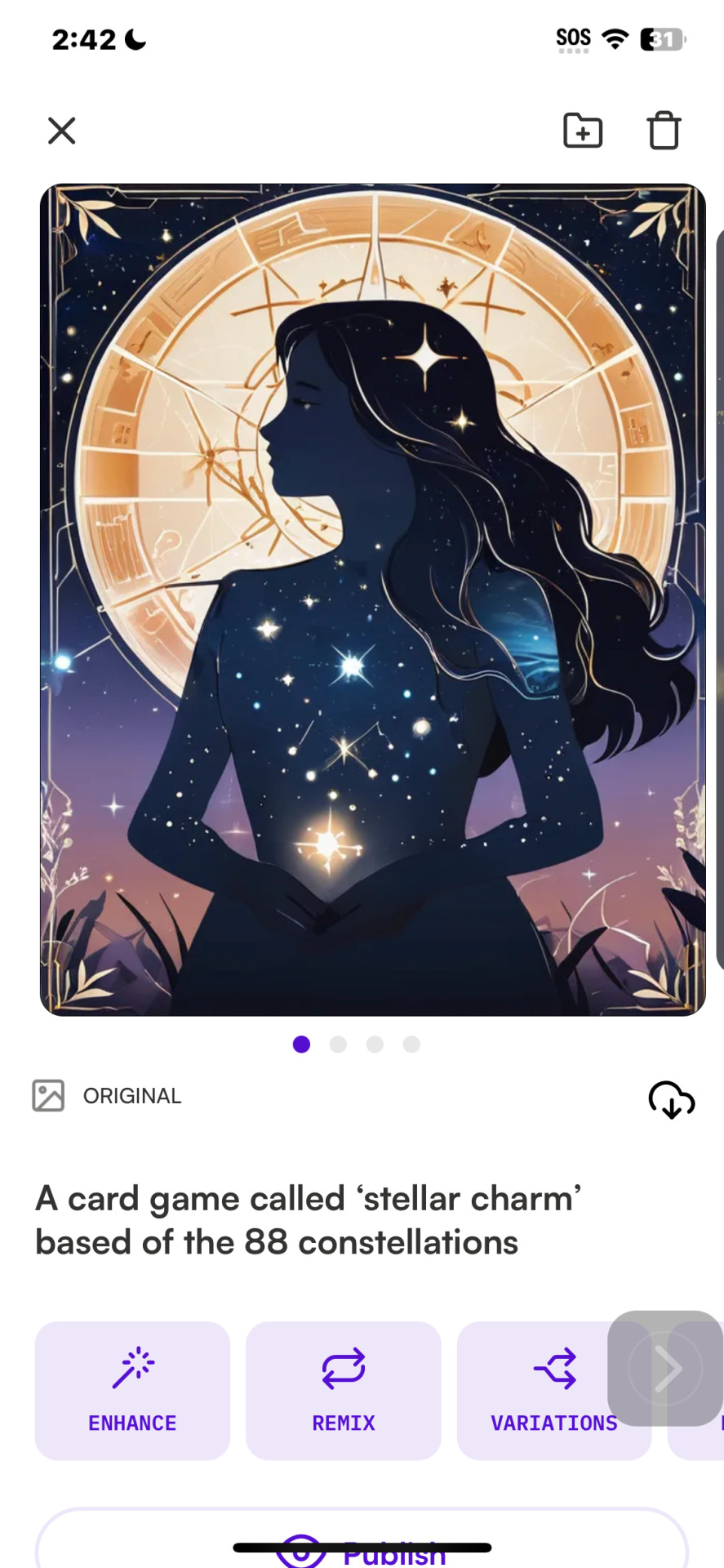

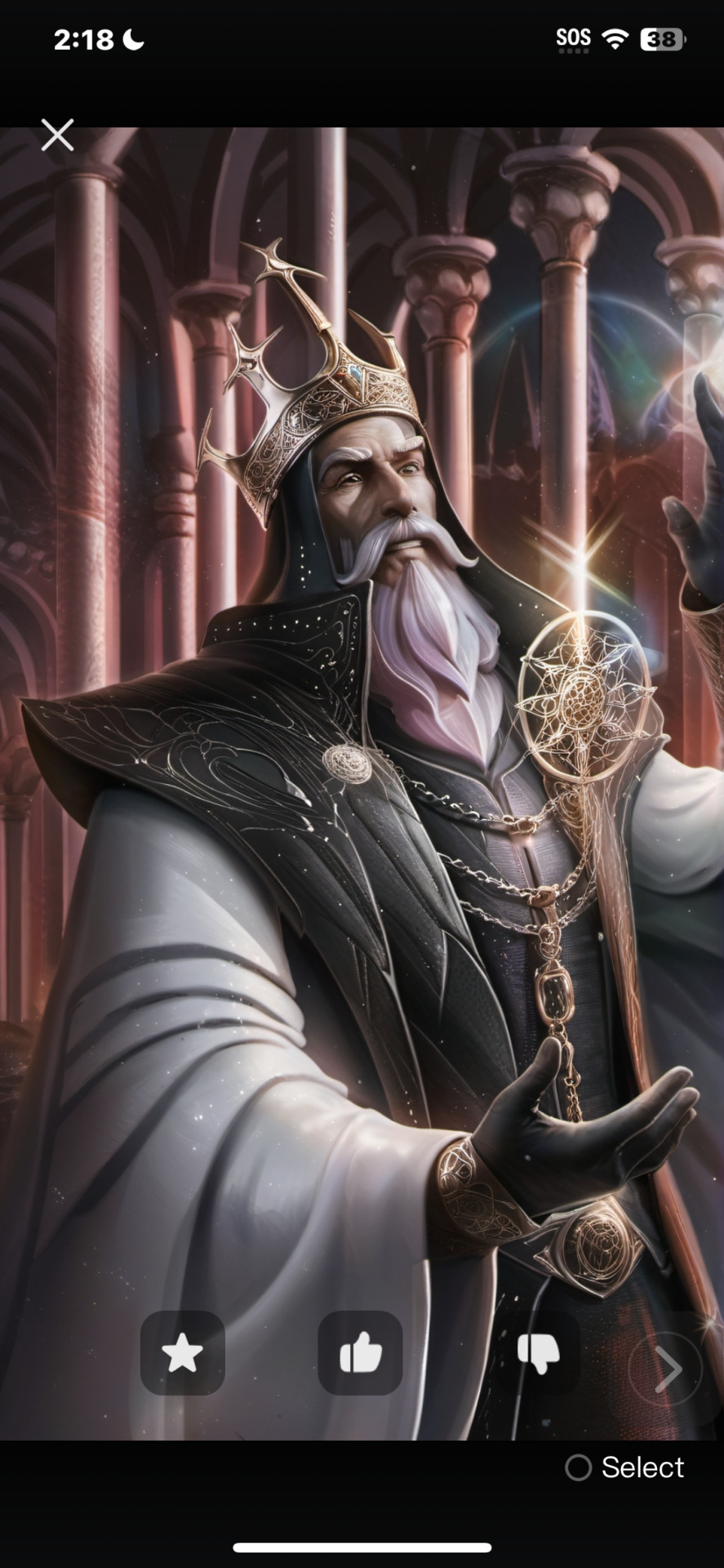
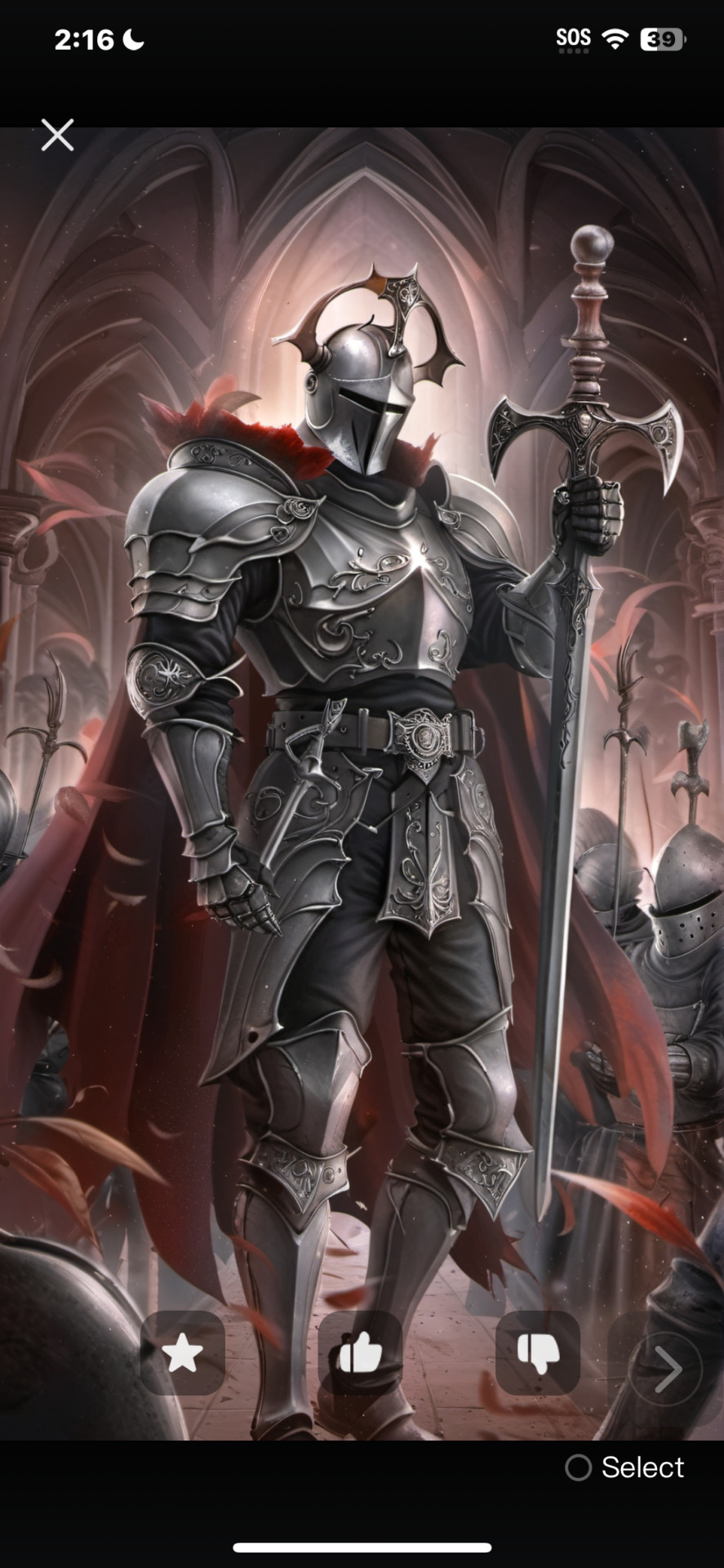
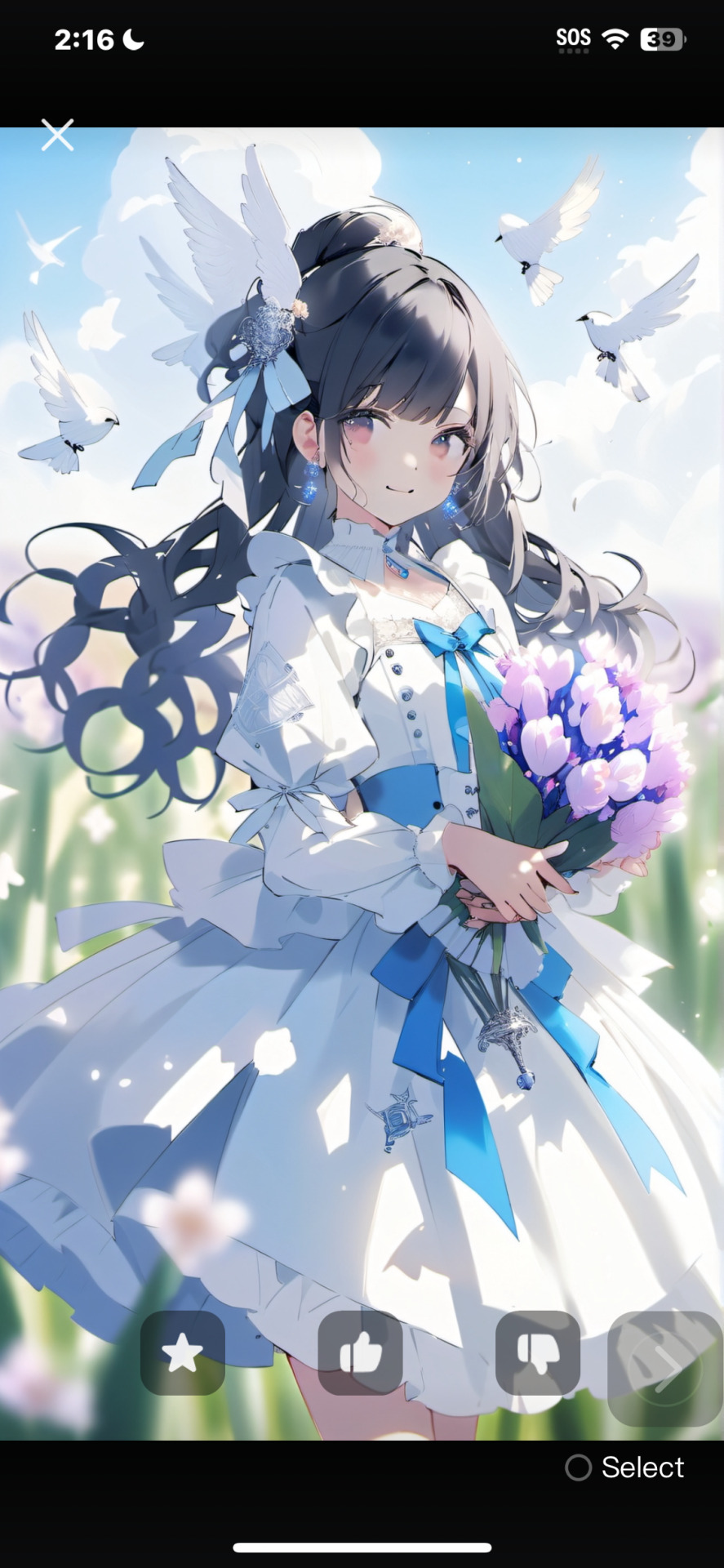

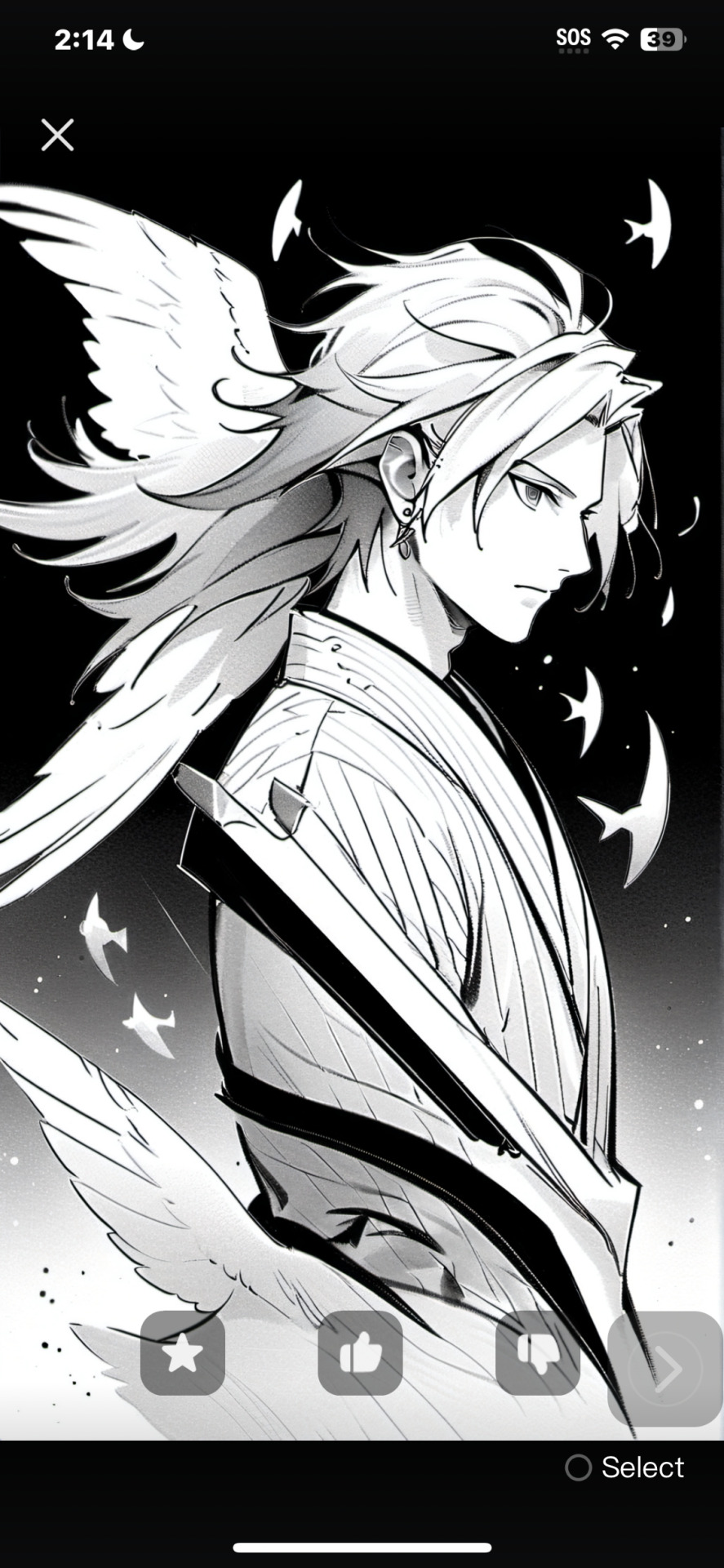
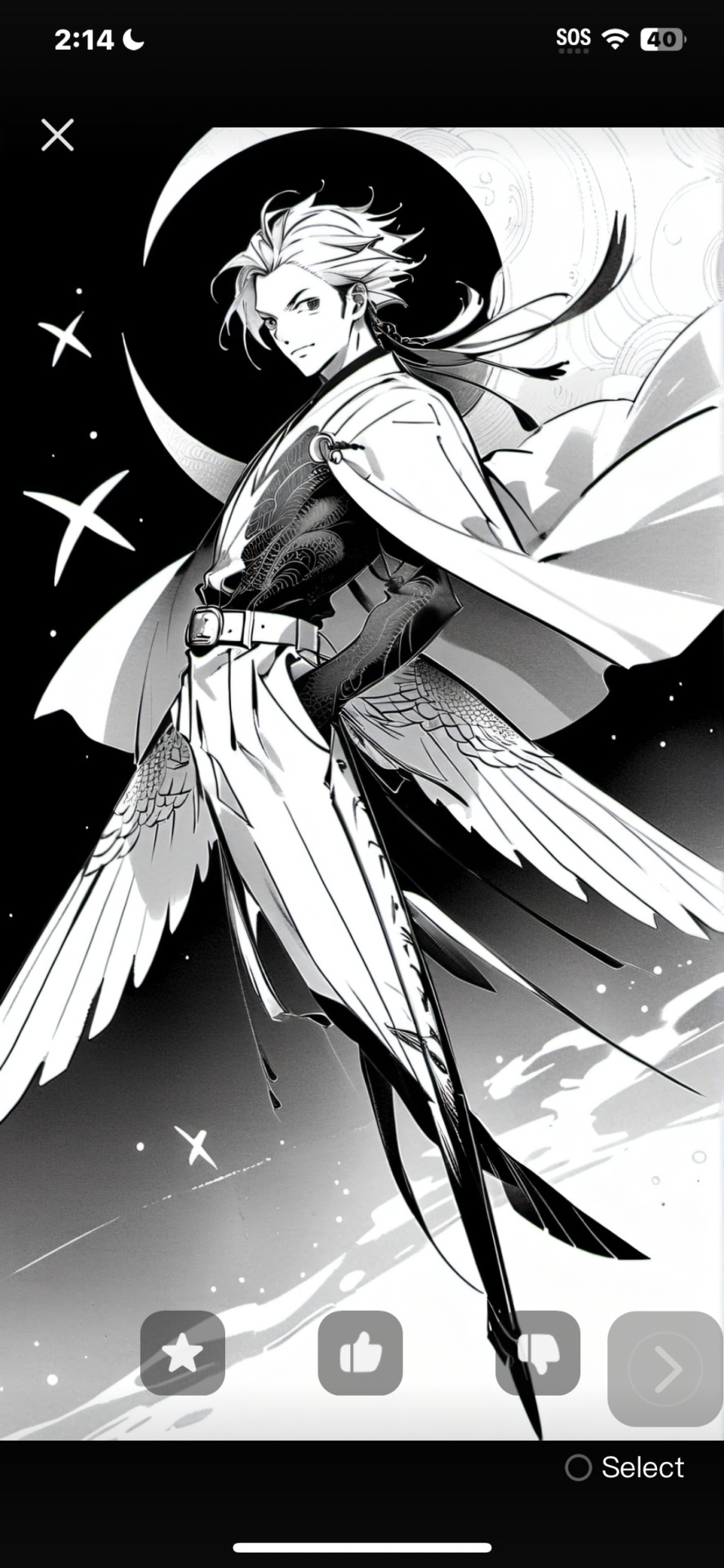



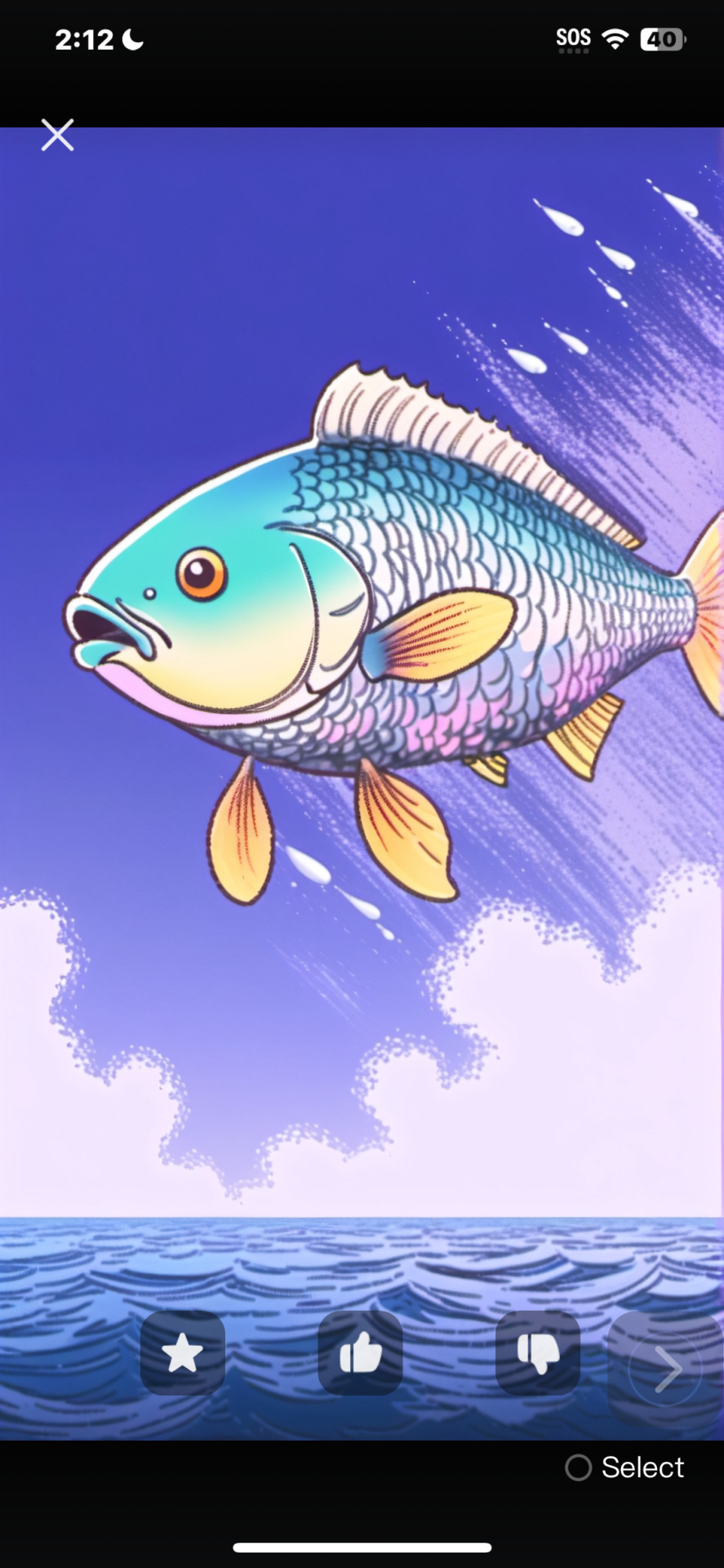



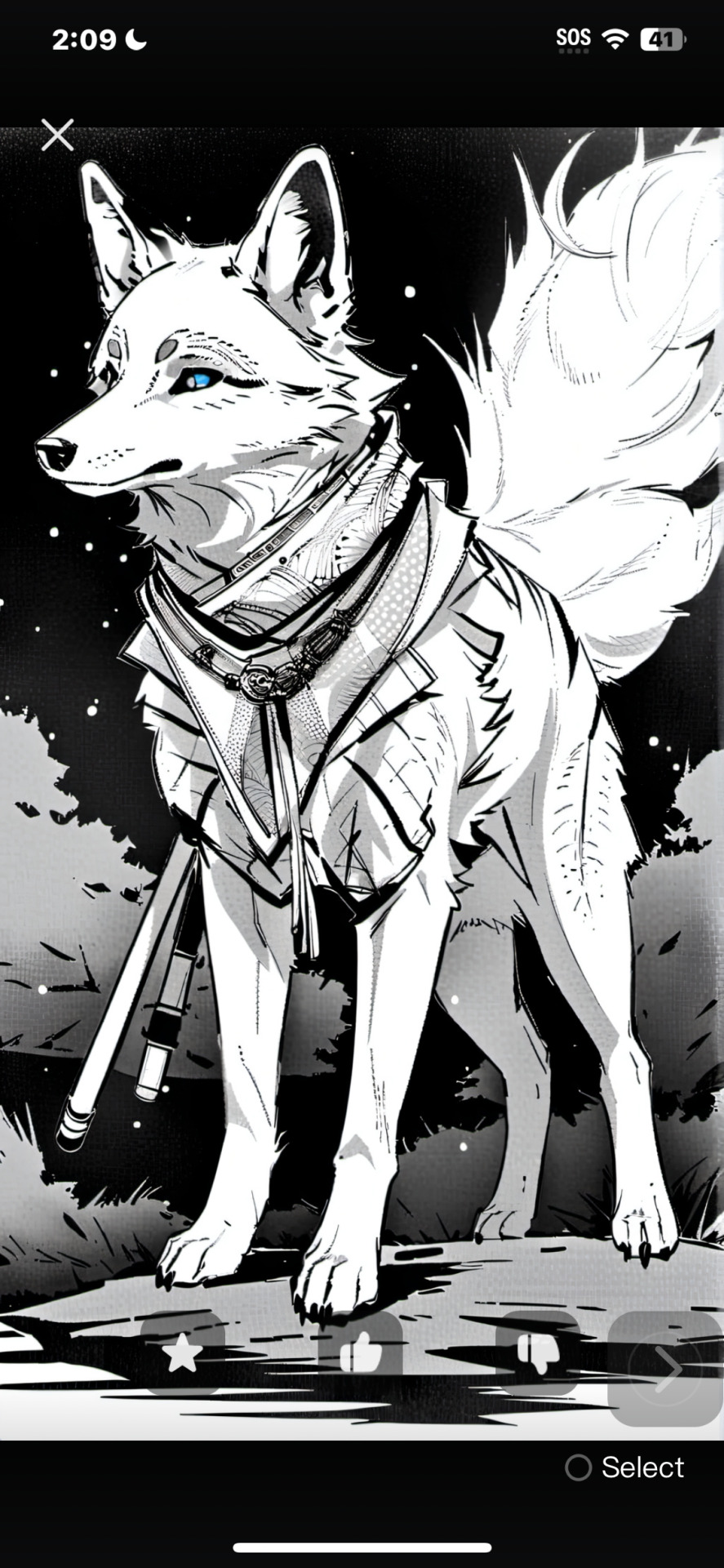
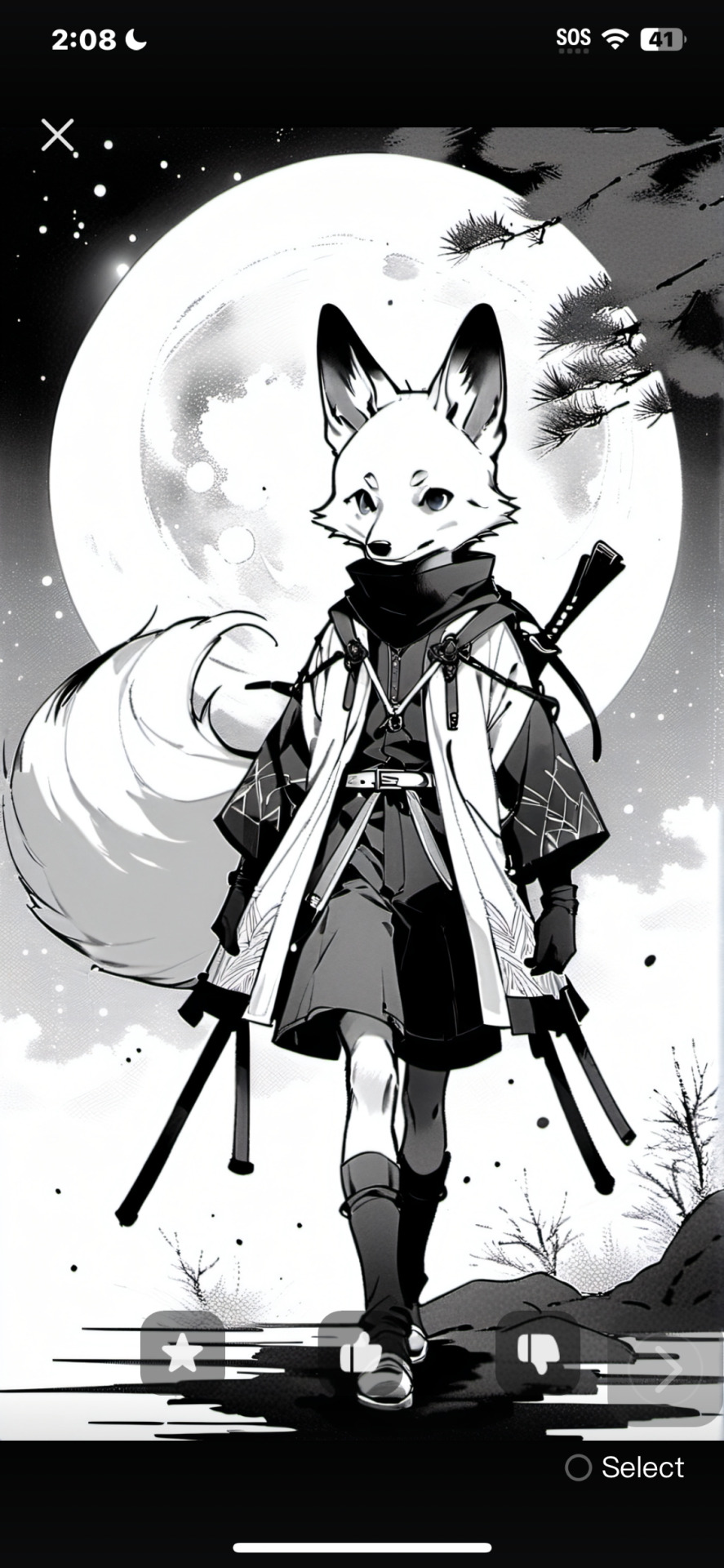


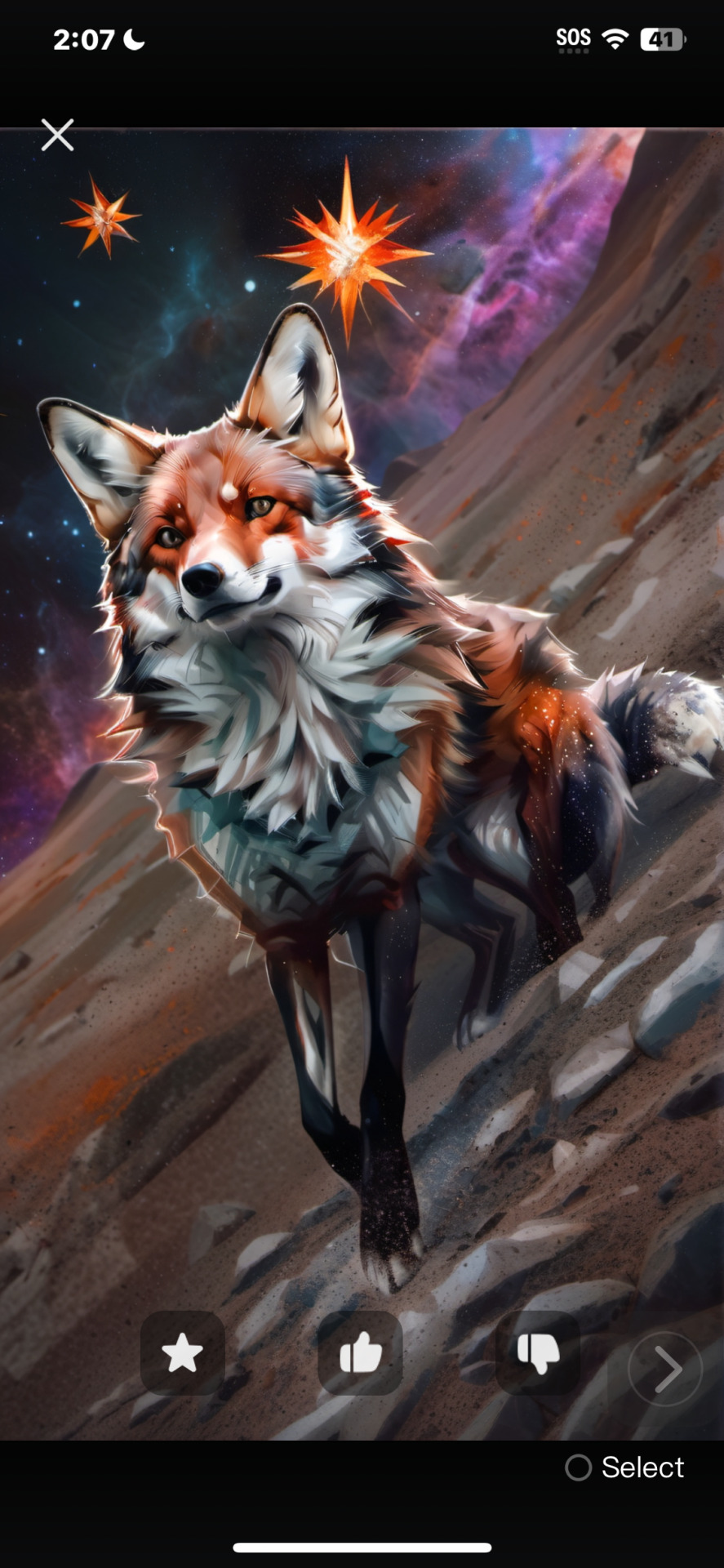
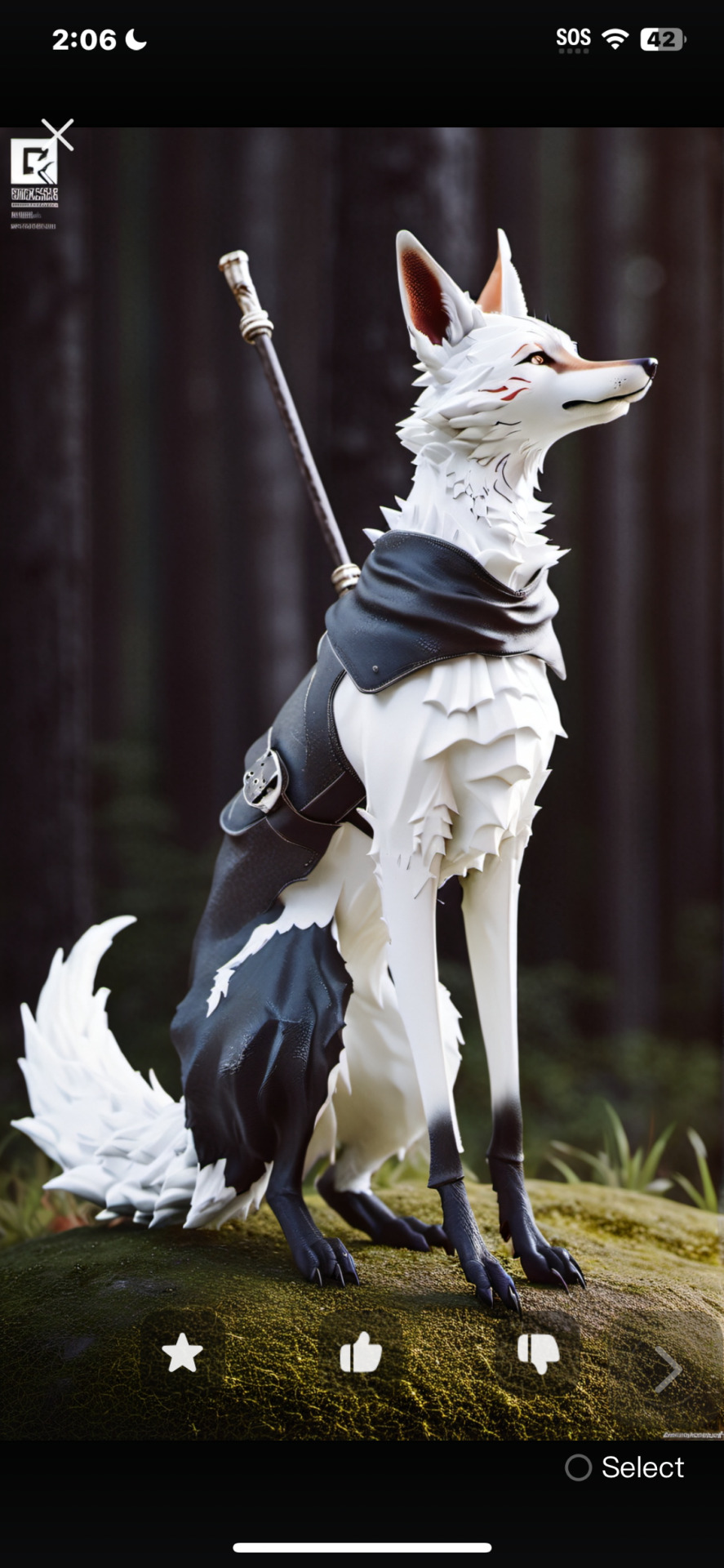


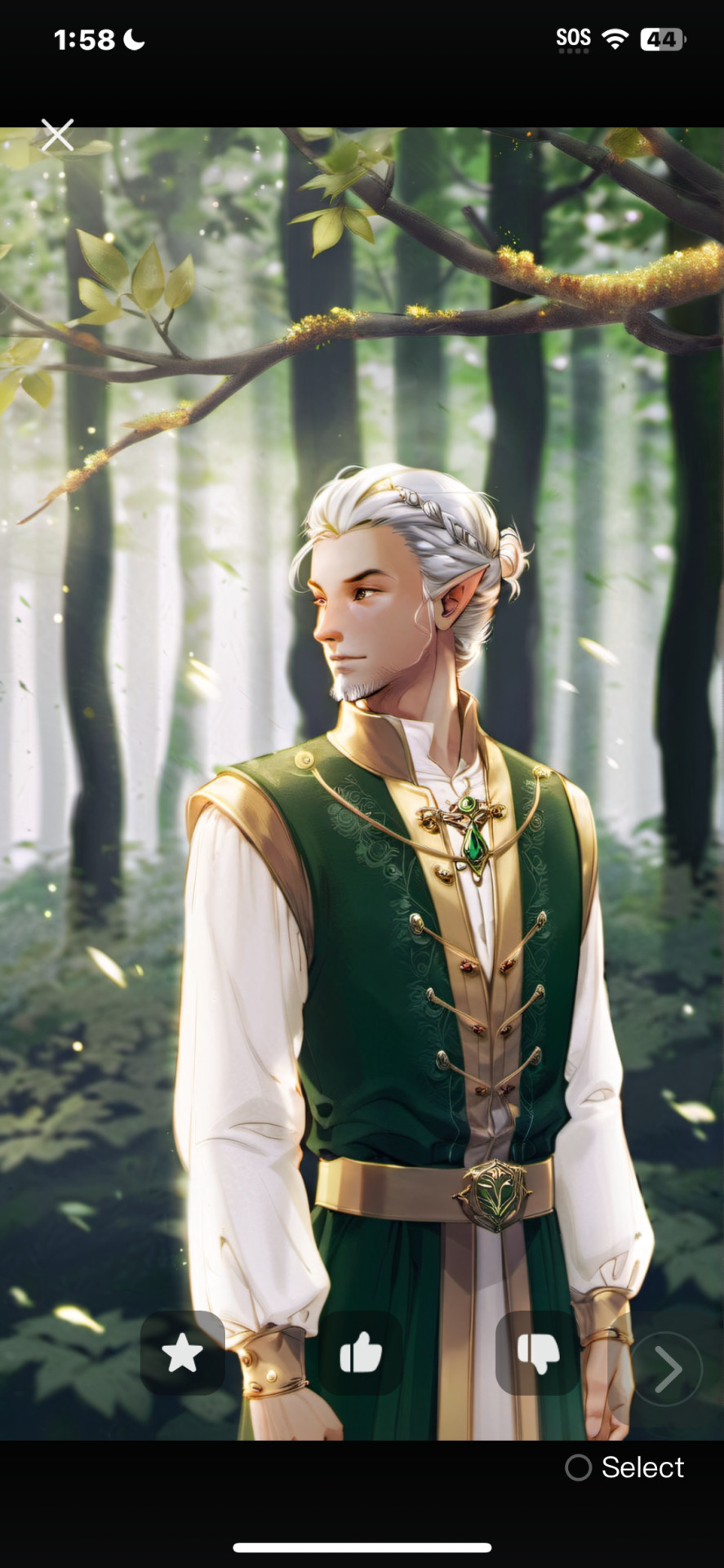

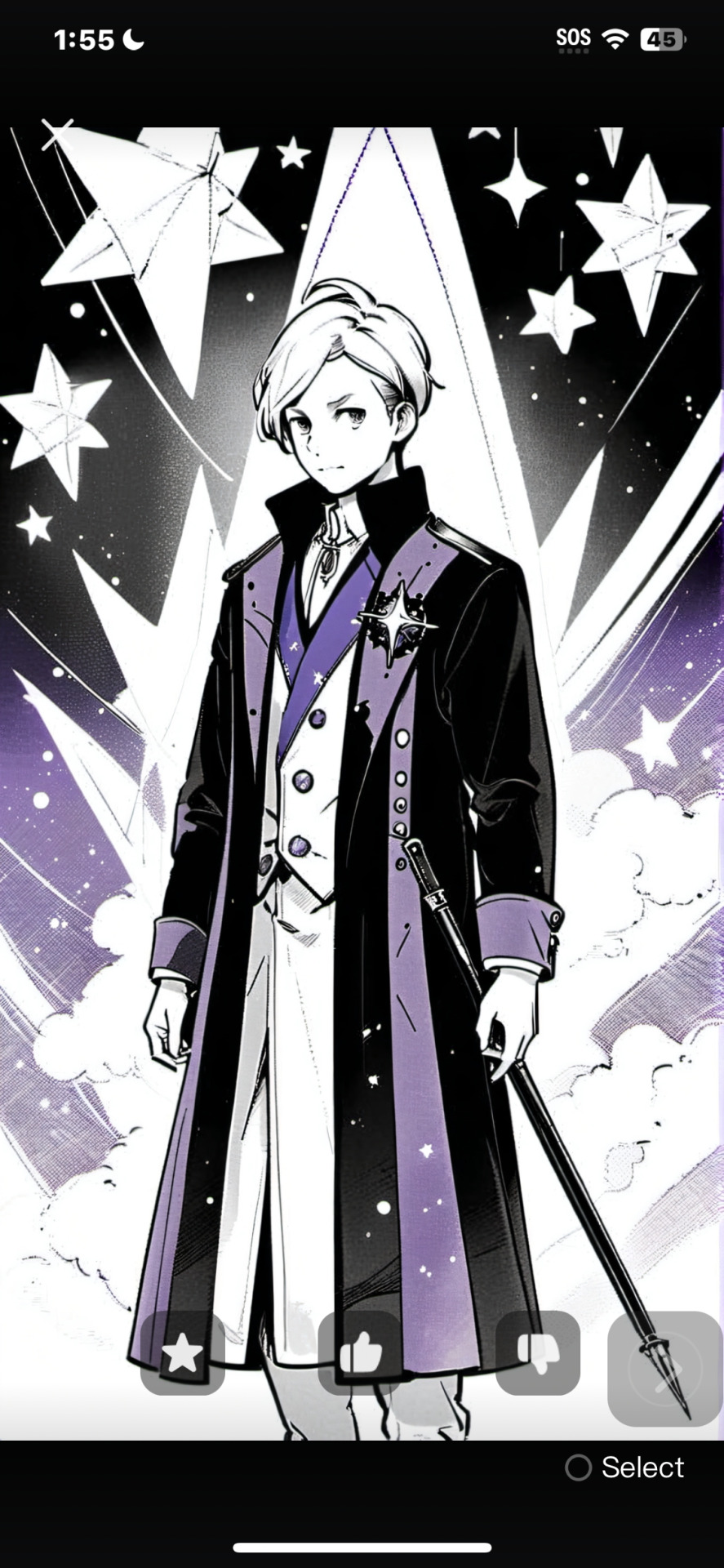
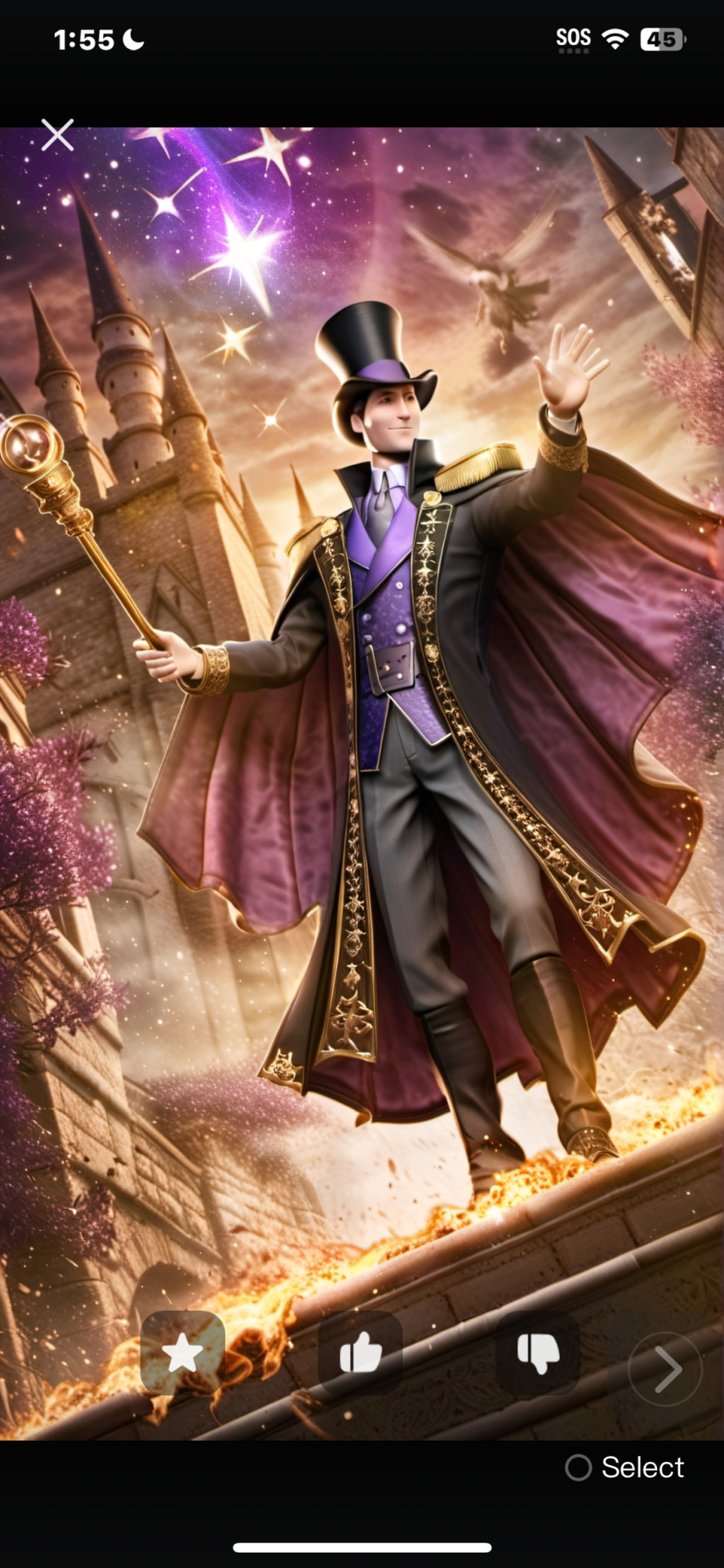
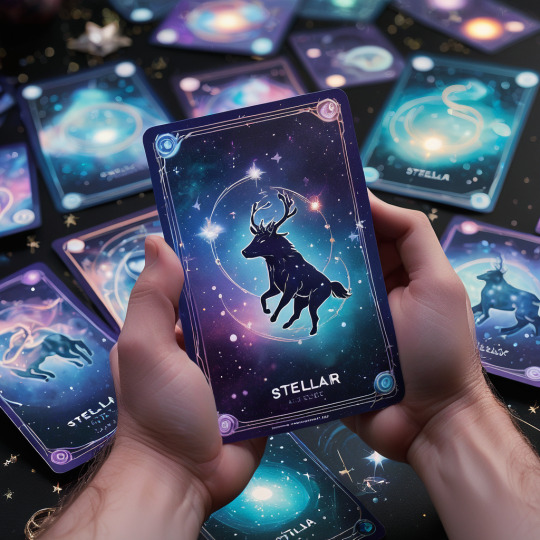
#Business model#play styles#card types#rules#objectives#card elements#stellar charm#battle strategy card game#TCG#Stellar Charm Cards
9 notes
·
View notes